Algebra Chapter 1 Factorization
Chapter 1 Factorization Of The Polynomials By Using Identities:
- In the previous chapter, you have already learned a lot about polynomials.
- In this present chapter, we shall study the processes or methods of how to factorize those polynomials.
- Before doing it, we want to know what we mean by factorization.
- By factorization of a polynomial, we generally mean that the polynomial should be represented as the product of two or more than two polynomials and each of the polynomials thus obtained is called a factor of the original polynomial.
- i.e., the given polynomial will be divisible by each of these factors.
- By the usual division algorithm, we can check it.
- For example, let x2 + 2x be a polynomial. We have to factorize it.
- Now, x2 + 2x = x (x + 2).
- the polynomial (x2 + 2x) is represented as the product of two polynomials x and x + 2, which are called factors of the polynomial x2 + 2x, i.e., x2 + 2x is divisible by both x and x + 2.
Read and Learn More WBBSE Solutions For Class 9 Maths
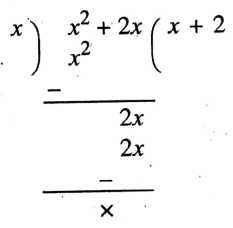
and
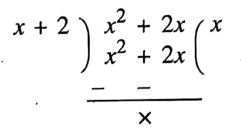
In this sub-chapter, we shall use the following identities to factorize the polynomials given:
- (a + b)2 = a2 + 2ab + b2 = (a – b)2 + 4ab
- {a – b)2 = a2 – 2ab + b2 = (a + b)2 – 4ab
- a2 + b2 = (a + b)2 – 2ab = (a – b)2 + 2ab
- a2 – b2 = (a + b)(a – b)
In the following examples, you shall know about the different processes of factorization of the polynomials using the above identities.
Examples 1. Factorize: 4x4 + 81.
Solution:
Given 4x4+81
4x4+81
= (2x2)2 +(9)2 = (2x2 +9)2 -2.2x2.9 [ Identity : a2 + b2 = (a + b)2 – 2ab ]
= (2x2 + 9) -(6x)2
= (2x2 + 9 + 6x) (2x2 +9-6x)
= (2x2 + 6x + 9) (2x2 -6x + 9)
4x4+81 = (2x2 + 6x + 9) (2x2 -6x + 9)
Question 2. Factorize: \(\frac{x^4}{16}\) – \(\frac{y^4}{81}\)
Solution:
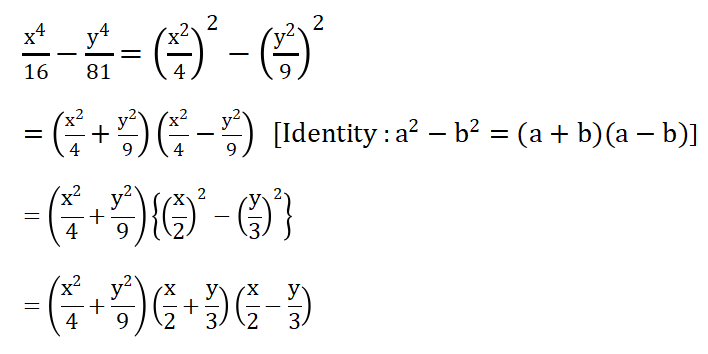
Question 3. Factorize: \(m^2+\frac{1}{m^2}+2-2 m-\frac{2}{m}\)
Solution:
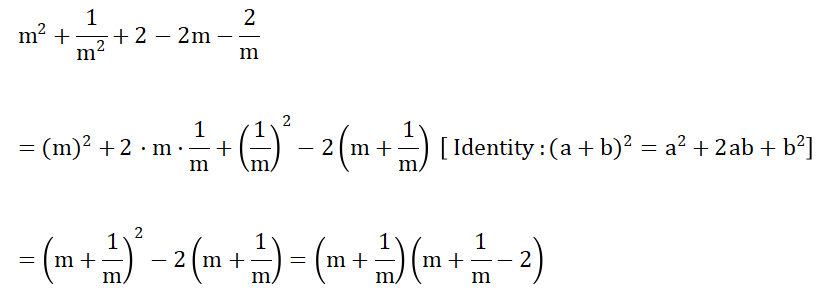
Question 4. Factorize: 3x (3x + 2z) – 4y (y + z).
Solution:
Given 3x (3x + 2z) – 4y (y + z)
3x (3x + 2z)- 4y (y + z)
= 9x2+ 6xz-4y2 -4yz
= (3x)2-(2y)2 +6xz-4yz
= (3x + 2y)(3x-2y) + 2z (3x-2y) [ Identity : a2 – b2 = (a + b) (a – b)]
= (3x – 2y)(3x + 2 y + 2z)
3x (3x + 2z) – 4y (y + z) = (3x – 2y)(3x + 2 y + 2z)
Question 5. Factorize : 3x2+4xy + y2 -2xz-z2
Solution:
Given 3x2+4xy + y2 -2xz-z2
3x2+4xy +y2-2xz- z2 = 4x2 -x2 +4xy+ y2 – 2xz – z2
= (2x)2 + 2.2x. y + (y)2 – (x2 + 2xz + z2)
= (2x + y)2 -(x + z)2 [ Identity : a2 + 2ab + b2 = (a + b)2]
= (2x + y + x + z)(2x + y-x-z) [ Identity : a2 – b2 = (a + b) (a – b)]
= (3x+y + z)(x+y-z)
3x2+4xy + y2 -2xz-z2 = (3x+y + z)(x+y-z)
Question 6. Factorize: x2-y2-6ax + 2ay +8a2
Solution:
Given x2-y2-6ax + 2ay +8a2
x2– y2-6ax +2ay +8a2 = (x)2-2.x.3a +(3a)2 – (a2-2ay + y2)
= (x – 3a)2 – (a- y)2 [ Identity : a2 – 2 ab + b2 = (a – b)2]
= (x-3a+a – y)(x-3a-a + y) [Identity : a2 – b2 = (a + b) (a – b)]
= (x-y-2a)(x + y-4a)
x2-y2-6ax + 2ay +8a2 = (x-y-2a)(x + y-4a)
Question 7. Factorise: a2– 9b2 + 4c2 – 25d2 – 4ac + 30bd
Solution :
Given a2– 9b2 + 4c2 – 25d2 – 4ac + 30bd
a2– 9b2 + 4c2 – 25d2 – 4ac + 30bd
= (a)2 – 2.a.2c + (2c)2 – {(3b)2 – 2.3b.5d + (5d)2)
= (a – 2c)2 – (3b – 5d)2 [ Identity : a2 – lab + ft2 = (a – ft)2]
= (a – 2c + 3b – 5d)(a – 2c – 3b + 5d) [ Identity : a2 – b2 = (a + b) (a – b)]
= (a + 3ft – 2c – 5d)(a – 3b – 2c + 5d)
a2– 9b2 + 4c2 – 25d2 – 4ac + 30bd = (a + 3ft – 2c – 5d)(a – 3b – 2c + 5d)
Question 8. (x2-y2)(a2– b2) + 4abxy.
Solution :
Given (x2-y2)(a2– b2) + 4abxy:-
(x2-y2){a2-b2)+ 4abxy = x2a2-y2a2-x2b2 + y2b2 +2abxy + 2abxy
= (xa)2 + 2.xa.yb + (yb)2 – {(xb)2 – 2.xb.ya + (ya)2 }
= (xa + yb)2 – (xb – ya)2 [Identity : a2 + 2ab + b2 = (a + b)2 ; a2 – 2ab + b2 = (a – b)2]
= (xa + yb + xb -ya)(xa + yb – xb + ya) [Identity: a2 – b2 = (a + b) (a – b)]
= (ax + bx – ay + by)(ax -bx + ay + by)
(x2-y2)(a2– b2) + 4abxy = (ax + bx – ay + by)(ax -bx + ay + by)
Question 9. Factorize: x2 – 2x – 22499.
Solution :
Given x2 – 2x – 22499:-
x2– 2x – 22499 = x2 – 2x+ 1 – 22500
= (x-1)2 – (150)2 [ Identity : a2 – 2ab + b2 = (a – b)2]
= (x – 1 + 150)(x – 1 – 150) [ Identity : a2 – b2 = (a + b) (a – b)]
= (x + 149)(x-151)
x2 – 2x – 22499 = (x + 149)(x-151)
Question 10.Factorize: 2b2c2+ 2c2a2+ 2a2b2-a4-b4 -c4.
Solution:
Given 2b2c2+ 2c2a2+ 2a2b2-a4-b4 -c4
2b2c2 +2c2a2 + 2a2b2 -a4-b4-c4
= 4b2c2 – 2b2c2 + 2c2a2 +2a2b2 -a4 – b4 -c4
= (2bc)2 – {(a2)2 +(-b2)2 +(-c2)2 + 2(a2)(-b2)+2(-b2)(-c2) + 2(-c2)(a2)}
= (2bc)2 -(a2 – b2 -c2)2 [ Identity : a2 + b2 + c2 + 2ab + 2bc + 2ca = (a + b + c)2]
= (2bc + a2 – b2 -c2)(2bc-a2 +b2 +c2 )
= {a2 -(b2 -2bc + c2)}(b2 + 2bc + c2) – a2 } = {(a)2 – (b- c)2} {(b + c)2 – (a)2 }
= (a + b – c)(a – b + c)(b + c + a)(b + c – a)
= (a + b + c)(b + c-a)(c + a-b)(a+b-c)
2b2c2+ 2c2a2+ 2a2b2-a4-b4 -c4 = (a + b + c)(b + c-a)(c + a-b)(a+b-c)
Question: 11 Factorize: \(x^4+\frac{1}{x^4}+1\)
Solution:
\(x^4+\frac{1}{x^4}+1=\left(x^2\right)^2+\left(\frac{1}{x^2}\right)^2+1\)
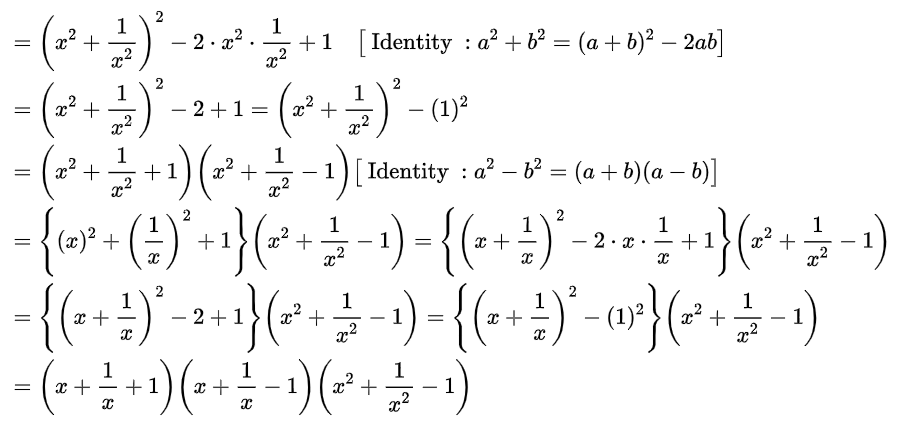
Question 12. Factorize : (x2 – 1)(y2 – 1) – 4xy.
Solution:
Given (x2 – 1)(y2 – 1) – 4xy
(x2– 1)(y2 – 1) – 4xy = x2y2 – x2 – y2 + 1 – 2xy -2xy
= (xy)2 – 2.xy.1 + (1)2-{(x)2+2.x.y + (y)2}
= (xy -1)2 – (x + y)2 [Identity : a2 – 1ab + b2 = (a – b)2 ; a2 + 1ab + b2 = (a + b)2 ]
= (xy -1 + x + y)(xy -1 – x – y)
= (xy + x + y – 1)(xy – x – y – 1)
(x2 – 1)(y2 – 1) – 4xy = (xy + x + y – 1)(xy – x – y – 1)
Question 13. Factorize: (a2-b2) x2 -2ax + 1
Solution :
Given (a2-b2) x2 -2ax + 1
(a2-b2) x2 -2ax+1
= a2x2 -b2x2 -2ax + 1
= (ax)2 – 2.ax.1+(1)2 – (bx)2
= (ax-1)2 – (bx)2 [ Identity : a2 – lab + b2 = (a – b)2 ]
= (ax-1 + bx)(ax-1-bx) [ Identity : a2 – b2 = (a + b) (a – b)]
= (ax + bx- l)(ax-bx-1)
(a2-b2) x2 -2ax + 1 = (ax + bx- l)(ax-bx-1)
Question 14. Factorize: p2 + 2p-(q +1 )(q -1)
Solution:
Given p2 + 2p-(q +1 )(q -1)
p2+2p-(q +1 )(q -1) = p2 + 2p-(q2 -1) [ Identity : (a + b) (a – b) = a2 – b2 ]
= p2 + 2p – q2 +1
= (p)2 +2.p.1+(1)2 -(q)2
= (P +1)2-(q)2 [ Identity : a2 + 1ab + b2 = (a + b)2 ]
= (p + 1 + q)(p + 1- q) [Identity : a2 – b2 = (a + b) (a – b)]
= (p + q + 1)(p-q + 1)
p2 + 2p-(q +1 )(q -1) = (p + q + 1)(p-q + 1)
Question 15. Factorize x (x -1) – y (y -1).
Solution:
Given x (x -1) – y (y -1)
x(x-1) – y (y-1) = x2 -x-y2 + y
= x2 – y2 – (x – y)
= (x + y)(x – y) – (x – y) [ Identity : a2 – b2 = (a + b) (a – Z>)}
= (x – y)(x + y – 1)
x (x -1) – y (y -1) = (x – y)(x + y – 1)
Question 16. Factorize: (a + b + 1)2 – 4(a + b)-25.
Solution:
Given (a + b + 1)2 – 4(a + b)-25
(a + b+ 1)2 – 4(a+b) – 25
= (a + b + l)2 – (3)2 – 4 (a + b) – 16 [ ∵ 25 = 9 + 16 ]
= (a + b + 1 + 3 )(a + b+ 1 – 3) – 4(a + 6 + 4)[ Identity : a2 – b2 = (a + b) (a – b)]
= (a + b + 4 )(a + 6-2) – 4(a + b + 4) = (a + b + 4)(a + b – 2 – 4)
= (a + b + 4)(a + b – 6 )
(a + b + 1)2 – 4(a + b)-25 = (a + b + 4)(a + b – 6 )
Question 17. Factorize: m4 + m2n2 + n4.
Solution:
Given m4 + m2n2 + n4
m4+ m2n2 + n4 =(m2)2+2.m2.n2+(n2)2-m2n2
= (m2 + n2) – (mn)2 [ Identity : a2 + 2ab + b2 = (a + b)2 ]
= (m2+ n2+ mn)(m2 + n2 – mn)
= (m2 + mn + n2)(m2 -mn+ n2)
m4 + m2n2 + n4 = (m2 + mn + n2)(m2 -mn+ n2)
Question 18. Factorize: a2 – b2 – c2 + 2bc.
Solution :
Given a2 – b2 – c2 + 2bc
a2– b2 – c2 + 2bc -a2 – [b2 – 2bc + c2)
= (a)2 -(b-c)2 [ Identity : a2 – 2ab + b2 = (a – b)2 ]
= (a + b -c)(a -b + c) [ Identity : a2 – b2 – (a + b) (a – b)]
a2 – b2 – c2 + 2bc = (a + b -c)(a -b + c)
Question 19. Factorize: a4 – 6a2 + 1.
Solution:
Given a4 – 6a2 + 1
a4– 6a2 + 1 = (a2) -2.a2.1+(1)2 – 4a2
= (a2 -1) -(2a)2 [ Identity : a2 – lab + b2 = (a – b)2 ]
= (a2 -1 + 2a ) (a2 -1 -2a) [ Identity : a2 – b2 = (a + 6) (a – b)]
= (a2+2a-1) (a2-2a-1)
a4 – 6a2 + 1 = (a2+2a-1) (a2-2a-1)
Question 20. Factorize: a8 + a4 + 1.
Solution:
Given a8 + a4 + 1
a8+ a4 + 1 = (a4)² +2.a4.1+(1)2 – a4
= (a4 +1) -(a2) [ Identity : a2 + 2ab + b2 = (a + b)2 ]
= (a4 + 1 + a2) (a4 + l-a2) [ Identity : a2 – b2 = (a + b) (a – b)]
={(a2)2 +2.a2.l + (l)2 – a2} (a4 -a2 +1)
= {(a2 +1) – (a)2} (a4 -a2 +1) [ Identity : «2 + 2a6 + b2 = (a + b)2]
= (a2+1+ a)(a2+1-a)(a4-a2+1) [ Identity : a2 – b2 = (a + b) (a – b)]
= (a2 +a +1) [a2 – a + 1) (a4 -a2 + 1)
a8 + a4 + 1 = (a2 +a +1) [a2 – a + 1) (a4 -a2 + 1)
Factorize : 4x2– 9y2 – 4xz + 6yz.
Solution :
Given 4x2– 9y2 – 4xz + 6yz
4X2– 9y2 – 4xz + 6yz = (2.x)2 – (3y)2 – 2z (2x – 3y)
= (2x + 3y)(2x-3y) – 2z (2x – 3y) [ Identity : a2 – b2 = (a + b) (a-b)]
= (2x – 3y)(2x + 3y – 2z)
4x2– 9y2 – 4xz + 6yz. = (2x – 3y)(2x + 3y – 2z)
22. Factorize : a2+ 2a – 323.
Solution :
Given a2+ 2a – 323
a2+ 2a – 323 =a2 + 2a +1-324
= (a + l)2 -(18)2 [ Identity : a2 + 2ab + b2 = (a + b)2]
= (a +1 +18)(a + 1-18) [ Identity : a2 – b2 = (a + 6)(a – b)]
= (a + 19)(a -17).
a2+ 2a – 323 = (a + 19)(a -17).
In this sub-chapter, we shall use the following identities to factorize the polynomials:
- a3 + b3 = (a + b)(a2 – ab + b2) = (a + b)3– 2ab (a+b)
- a3– b3= (a – b)(a2+ab+ b2)= (a – b)3 +3ab(a – b)
- (a+ b)3 = a3 + b3 + 3a2b+ 3ab2 = a3 + b3+ 3ab (a + b)
- (a- b)3=a3 – b3-3a2b + 3ab2 = a3 – b3 -3ab(a-b)
- a3 + b3 + c3– 3abc = (a + b + c)(a2 + b2 +c2 – ab – bc – ca)
= \(\frac{1}{2}\)(a + b + c){(a – b)2 +(b-c)2 +(c-a)2}
If a + b + c = 0, then a3 + b3 + c3 – 3abc = 0 x (a2 + b2 + c2 – ab – bc – ca)
or, a3 + b3 + c3 – 3abc = 0
or, a3 + b3 + c3 = 3abc.
Algebra Chapter 1 Factorization Select The Correct Answer (MCQ)
Example 1.
1 If (x – a)3 + (x – b)3 + (x – c)3 – (x – a)(x – b)(x – c) = 0, then
1. a
2. b
3. c
4. \(\frac{a+b+c}{3}\)
Solution:
(x – a)3+ (x – b)3 + (x – c)3 – 3(x – a)(x – b)(x – c) = 0
(x-a + x- b + x- c){(x – a)2 + (x – b)2 + (x – c)2 – (x – a)(x – b) – (x – b)(x – c) – (x – c)(x – a)} = 0
(3x – a – b – c) = 0
3x = a + b + c
x = \(\frac{a+b+c}{3}\)
∴ The correct answer is 4. \(\frac{a+b+c}{3}\)
2. The number of factors of (a6 – b6) is—
1. 1
2. 2
3. 3
4. 4
Solution:
(a6 – b6)
= (a3)2 – (b3)2
= (a3 + b3)(a3 – b3)
= (a + b)(a2 – ab + b2)(a – b)(a2 + ab + b2)
∴ The number of factors = 4
∴ the correct answer is 4. 4
3. (413+ 1) is divisible by
1. 40
2. 2.
3.42
4. 43
Solution:
413+ 1 = (41)3+ (1)3
= (41 + 1){(41)2 – 411 + (1)2}
= 42 (412 -41+1)
(413 + 1) is divisible by 42.
∴ The correct answer is 3. 42.
4. If a = -1, b = 2, c = 3, then \(\frac{a^3+b^3+c^3-3 a b c}{(a-b)^2+(b-c)^2+(c-a)^2}\) =
1. 0
2. – 1
3. 1
4. 2
Solution:
\(\frac{a^3+b^3+c^3-3 a b c}{(a-b)^2+(b-c)^2+(c-a)^2}\)
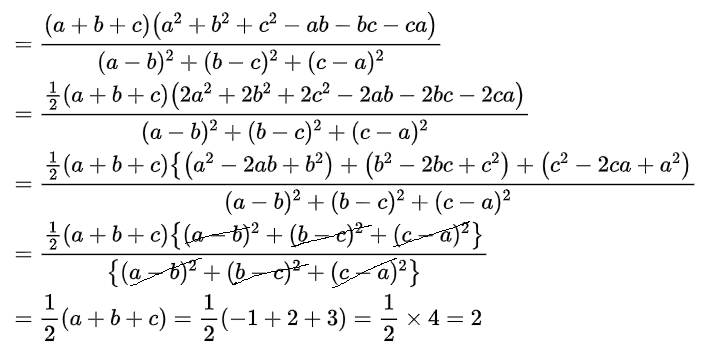
∴ the correct answer is 4. 2
5. \(\frac{(4.125)^3-(0.125)^3}{(4.125)^2 \cdot+4.125 \times 0.125+(0.125)^2}=?\)
1. 4.25
2. 4
3. -4.25
4. -4
Solution:
\(\frac{(4.125)^3-(0.125)^3}{(4.125)^2 \cdot+4.125 \times 0.125+(0.125)^2}\)

∴ The correct answer is 2. 4
6. \(\frac{(999)^3-1}{(999)^2-1}=?\)
1. 1000
2. 998
3. 999.01
4. 999.001
Solution:
\(\frac{(999)^3-1}{(999)^2-1}\)

∴ the correct answer is 4. 999.01
7. If a3 + b3 + c3 – 3abc = k (a + b + c){(a – b)2 + (b – c)2 + (c – a)2}, then k =
1. 0
2. \(\frac{1}{2}\)
3. \(– \frac{1}{2}\)
4. 2.
Solution:
a3 + b2 + c3 – 3abc = k (a + b + c){(a – b)2 + (b – c)2 + (c – a)2}
= (a + b + c)(a2 + b2 + c2 – 3abc)
= k (a + b + c)(a2 – 2ab + b2 + b2 – 2be + c2 + c2 – 2ca + a2)
= (a + b + c)(a2 + b2 + c2 – 3abc)
= k (a + b + c)(2a2 + 2b2 + 2c2 + 2ab – 2be – 2cd)
= (a + b + c)(a2 + b2 + c2 – 3abc)
= 2k (a + b + c)(a2 + b2 + c2 – ab – bc – ca)
2k = 1
k = \(\frac{1}{2}\)
∴ The correct answer is 2. \(\frac{1}{2}\)
Algebra Chapter 1 Factorization Short Answer Type Questions
Examples 1. Factorize: 24a3– 3.
Solution:
Given 24a3– 3
24a3– 3 = 3 (8a3 – 1)
= 3{(2a)3-(1)3}
= 3(2a-1){(2a)2 + 2a.1 + (1)2}
= 3 (2a – 1)(4a2 + 2a + 1)
24a3– 3 = 3 (2a – 1)(4a2 + 2a + 1)
Question 2. Factorize : x3– 6x + 4.
Solution:
Given x3– 6x + 4
x3 – 6x + 4 = x3 – 6x + (12 – 8)
= x3 – 8 – 6x + 12
= (x – 2)(X2 + x.2 + 22) – 6(x – 2)
= (x – 2)(x2 + 2x+ 4) – 6(x – 2)
= (a – 2)(a2 + 2a + 4 – 6)
= (x – 2)(x2 + 2x – 2)
x3 – 6x + 4 = (x – 2)(x2 + 2x – 2)
Question 3. Factorize: x3 – 4x + 3.
Solution :
Given x3 – 4x + 3
x3– 4x + 3 = x3 – 4x + (4 – 1)
= x3– 1 – 4a + 4
=(x)3 – (1)3 – 4x + 4
= (a – 1)(a2 + a. 1 + 12) – 4(a – 1)
= (x – 1)(x2 + x +1 – 4)
= (x – 1)(x2 + x – 3)
x3– 4x + 3 = (x – 1)(x2 + x – 3)
Question 4. Factorize: a3 + 5x – 6.
Solution :
Given a3 + 5x – 6
x3+ 5x – 6 = a3 + 5a – (5 + 1)
= x3 – 1 + 5x – 5
= (x)3 – (1)3 + 5x – 5
= (x – 1 )(x2 +x.1 +12) + 5(x – 1)
= (x – 1)(x2 + a + 1) + 5 (x – 1)
= (x – 1)(x2 +x + 1+ 5)
= (x – 1)(x2 + x + 6)
x3+ 5x – 6 = (x – 1)(x2 + x + 6)
Question 5. Factorize: x3 – 3x + 2.
Solution:
Given x3 – 3x + 2
x3– 3x + 2 = x3 – 3x + (3 – 1)
= x3 – 1 -3x + 3
= (x)3 – (1)3 – 3x + 3
= (x – 1)(x2+ x.1 +12) – 3 (x -1)
= (x – 1)(x2 + x + 1) – 3 (x – 1)
= (x – 1)(x2+ x + 1- 3)
= (x -1)(x2 + x – 2)
= (x – 1)(x2 -1 + x – 1)
= (x – 1){(x + 1)(x -1) + 1 (x -1)}
= (x – 1)(x – 1)(x + 1 + 1)
= (x – 1)2(x + 2)
x3– 3x + 2 = (x – 1)2(x + 2)
Question 6. Factorize: m6 – 64n6.
Solution:
Given m6 – 64n6
m6 – 64n6 = (m3) -(8n3)2
= (m3+8n3)(m3-8n3)
= {(m)3+ (2n)3}{(m)3 – (2n)3}
= (m + 2n) |(m)2 – m.2n + (2n)2 {(m – 2n){(m)2 + m.2n + (2n)2}
= (m + 2n)(m2 -2mn + 4n2)(m-2n)(m2 +2mn + 4n2)
= (m – 2n)(m + 2n)(m2 -2mn + 4n2)(m2 + 2mn + 4n2)
m6 – 64n6 = (m – 2n)(m + 2n)(m2 -2mn + 4n2)(m2 + 2mn + 4n2)
Question 7. Factorize: x3 + 2x + 3.
Solution :
Given x3 + 2x + 3
x3+ 2x + 3 = x3 + 2x + (2 + 1)
= x3 + 1 + 2x + 2
= (x)3 + (1)3 + 2x + 2
= (x + 1)(x2 – x + 1) + 2 (x + 1)
= (x + 1)(x2 – x + 1+ 2)
= (x + 1)(x2 -x +3)
x3+ 2x + 3 = (x + 1)(x2 -x +3)
Question 8. Factorize : 2a3 -a2 – 1.
Solution :
Given 2a3 -a2 – 1
2a3– a2 – 1 = 2a3 – a2 – (2 – 1)
= 2a3 – 2 – a2 + 1
= 2 (a3 – 1) – 1 (a2-1)
= 2 (a – 1 )(a2 + a + 1) – 1 (a – 1)(a+ 1)
=(a-1){2(a2 +a + 1)-1(a + 1)}
= (a – 1)(2a2 + 2a + 2 – a – 1)
= (a – 1)(2a2 + a + 1)
2a3– a2 – 1 = (a – 1)(2a2 + a + 1)
Question 9. Factorize: 3y3 + 2y + 5.
Solution:
Given 3y3 + 2y + 5
3y3+ 2y + 5 = 3y3 + 2y + (3 + 2)
= 3y3 + 3 + 2y + 2
= 3 (y3 + 1) + 2 (y + 1)
= 3 {(y)3 +(1)3} + 2(y + 1)
=3(y + l)(y2-y + 1) + 2(y + 1)
= (y + 1) {3(y2-y + 1) + 2}
= (y + 1)(3y2-3y + 3 + 2)
= (y + 1)(3y2 -3y + 5)
3y3+ 2y + 5 = (y + 1)(3y2 -3y + 5)
Question 10. Factorize: a3 – 12a – 16.
Solution:
Given a3 – 12a – 16
a3– 12a. – 16 = a3 – 12a – (24 – 8) = a3 + 8 – 12a – 24
= (a)3 + (2)3 – 12a – 24
= (a + 2) ((a)2 -a.2 + 22)-12(a + 2)
= (a + 2)(a2-2a + 4)-12(a + 2)
(a + 2)(a2-2a + 4-12) = (a + 2)(a2 -2a-4-4)
= (a + 2){(a)2-(2)2-2a-4}
= (a + 2) {(a + 2)(a – 2) – 2(a + 2)}
= (a + 2)(a + 2)(a – 2 – 2)
= (a + 2)2(a-4).
a3– 12a. – 16 = (a + 2)2(a-4).
(a + 2)(a2-2a + 4-12) = (a+2)(a2-2a-8)
=(a+ 2)(a2-4a+2a-8)
= (a + 2) {a(a – 4) + 2(a – 4)}
= (a + 2)(a – 4)(a + 2)
= (a + 2)2(a-4)
Question 11. Factorize: a3 + 5a + 6.
Solution :
Given a3 + 5a + 6
x3+ 5x + 6 = x3 + 5x + (5 + 1)
= x3 + 1 + 5x + 5
= (x)3 + (1)3 + 5x + 5
= (x + 1 )(x2 – x + 1) + 5 (x + 1)
= (x + 1)(x2 – x + 1 + 5)
= (x + 1)(x2 – x + 6).
a3 + 5a + 6 = (x + 1)(x2 – x + 6).
Question 12. Factorize: p3 – 7p – 6.
Solution:
Given p3 – 7p – 6
p3– 7p – 6 = p3 – 7p – (7 – 1)
= p3 – 7p – 7 + 1
= (p)3 + (1)3 – 7p -1
=(p + 1)(p2 – p + 1) – 7(p + 1)
= (P+ 1)(p2 – p + 1 – 7)
= (p + 1)(p2-p -6)
= (p + 1)(p2 – 3p + 2p – 6)
= (p + 1){p(p-3) + 2(p-3)}
= (p + 1)(p – 3)(p + 2)
= (p + 1)(p + 2)(p – 3)
p3 – 7p – 6 = (p + 1)(p + 2)(p – 3)
Question 13. Factorize : x3 – 3x2 + 4.
Solution:
Given x3 – 3x2 + 4
x3– 3x2 + 4 = x3 – 3x2 + (3 + 1)
= (x)3 + (1)3 – 3x2 + 3
= (x + 1)(x2 – x + 1) – 3 (x2 – 1)
= (x + 1)(x2 – x + 1) – 3 (x + 1)(x – 1)
={(x +1) (x2 – x + 1-3)(x-1)}
= (x+ 1)(x2 – x + 1 -3x + 3)
= (x + 1)(x2 -4x + 4)
= (x+1){(x)2-2.x.2 + (2)2}
= (x + 1)(x – 2)2
x3 – 3x2 + 4 = (x + 1)(x – 2)2
Question 14. Factorize : a³ – a² – 18.
Solution :
Given a³ – a² – 18
a³ – a² – 18 = a³ – a² – (27 – 9)
= a³ – 27 – a² + 9
= (a)³ – (3³-{(a)² -(3)²}
= (a-3) {(a)² + a.3+(3)²}-(a + 3)(a -3)
= (a – 3)(a² + 3a + 9) – (a + 3)(a -3)
= (a – 3)(a² + 3a + 9 – a – 3)
= (a – 3)(a² + 2a + 6)
a³ – a² – 18 = (a – 3)(a² + 2a + 6)
Question 15. Factorize : 8a³ + 4a – 3.
Solution :
Given 8a³ + 4a – 3
8a³ + 4a – 3 = 8a³ + 4a – (2 + 1)
= 8a³ + 4a – 2 – 1
= (2a)³ – (1)³ + 4a – 2
= (2a – 1){(2a)² + 2a.1 + (1)²} + 2 (2a – 1)
= (2a – 1)(4a² + 2a + 1) + 2 (2a – 1)
= (2a – 1)(4a² + 2a + 1 + 2)
= (2a – 1)(4a² + 2a + 3)
8a³ + 4a – 3 = (2a – 1)(4a² + 2a + 3)
Question 16. Factorize: x6 + 27.
Solution :
Given x6 + 27
x6 + 27 = (x²) + (3)³
= (x²+3){(x²)² – x².3 + (3)²}
= (x² + 3)(x4-3×2+9)
= (x² + 3){(x²)² +2.x².3 + (3)2 -9x²}
= (x² + 3){(x² + 3)² -(3x)²}
= (x² + 3)(x² +3 + 3x)(x² +3-3x)
= (x²+ 3)(x² + 3x + 3)(x² – 3x + 3)
x6 + 27 = (x²+ 3)(x² + 3x + 3)(x² – 3x + 3)
Question 17. Factorize: x6 – 64.
Solution:
Given x6 – 64
x6– 64 = (x3)2 -(8)2
= (x3 +8)(x3 -8)
= {(x)3 + (2)3}{(x)3 – (2)3}
= (x + 2)(x2 – x.2 + 22)(x-2)(a2 + x.2 + 22)
= (x + 2)(x2 – 2x + 4)(x – 2)(x2 + 2a + 4)
= (x-2)(x + 2)(x2-2x + 4)(x2 +2x + 4)
x6– 64 = (x-2)(x + 2)(x2-2x + 4)(x2 +2x + 4)
Question 18. Factorize: 8 (x – 3)3 + 343.
Solution:
Given 8 (x – 3)3 + 343
8 (x- 3)3 + 343 = {2(x-3)}3 + (7)3 = (2x-6)3 + (7)3
= (2x – 6+ 7) {(2x-6)2-(2x-6).7 + (7)2 }
= (2x + 1) {(2x)2 – 2.2x.6 + (6)2 – 14x + 42 + 49}
= (2x + 1)(4x2-24x + 36 – 14x + 91)
= (2x +1)(4x2 – 38x +127)
8 (x – 3)3 + 343 = (2x +1)(4x2 – 38x +127)
Question 19. Factorize: x12 – y12
Solution:
Given x12 – y12
x12– y12 = (x6)2 – (y6)2
= (x6 + y6)(x6 – y6)
= {(x2)3 + (y2.)3}{(x3)2 + (y)3)2)}
= [(x2 + y)2{(x2)²- x2y2 +(y2)2}][(x3 + y3)(x3 -y3)]
= {x2+ y2}[x4-x2y2+y4](x+y)(x2-xy + y2}(x-y)(x2+xy + y2)
= (x – y)(x + y)(x2 + y2)(x2 -xy + y2)(x2 + xy + y2)(x4 -x2y2+y4)
x12 – y12 = (x – y)(x + y)(x2 + y2)(x2 -xy + y2)(x2 + xy + y2)(x4 -x2y2+y4)
Question 20. Factorize: t 9 – 512.
Solution:
Given t 9 – 512
t9 – 512 = (t3)3-(8)3
= (t3-8)((t3)2 + t3.8 + (8)2)
= {(t)3-(2)3} {t6+8t3+64}
= (t-2)(t2+t2 + 22)(t6+ 8t3+ 64)
= (t-2)(t2 +2t + 4)(t6 + 8t3 + 64)
t 9 – 512= (t-2)(t2 +2t + 4)(t6 + 8t3 + 64)
Question 21. Factorize: \(\frac{1}{8 a^3}+\frac{8}{b^3}\)
Solution:
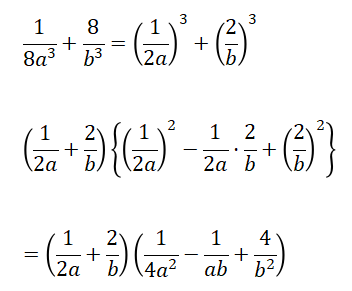
Question 22. Factorize: a 3 + 3a2b + 3ab2 + ft3 – 8.
Solution :
Given a 3 + 3a2b + 3ab2 + ft3 – 8
a3+ 3a2b + 3ab2 + b3 – 8 = (a+b)3 – (2)³
= (a + b – 2){(a + b)2 + (a + b).2 + 22 }
= (a+b-2)(a2 + 2ab + b2 + 2a + 2b + 4).
a 3 + 3a2b + 3ab2 + ft3 – 8 = (a+b-2)(a2 + 2ab + b2 + 2a + 2b + 4).
Question 23. Factorize: 8a3 – b3 – 4ax + 2bx.
Solution:
Given 8a3 – b3 – 4ax + 2bx
8a3– b3 – 4ax + 2bx = (2a)3 – (b)3 – 4ax + 2bx .
= (2a – b) {(2a)2 + 2a.b + (b)2 } – 2x (2a – b)
= (2a-b)(4a2 +2ab + b2}-2x(2a-b)
= (2a-b)(4a2 +2ab + b2-2x)
8a3 – b3 – 4ax + 2bx = (2a-b)(4a2 +2ab + b2-2x)
Question 24. Factorize: x3 -6x2 + 12x – 35.
Solution:
Given x3 -6x2 + 12x – 35
x3– 6x2 + 12x – 35 = (x)3 – x2.2 + 3x.22 -(2)3 -27
= (x – 2)3 – (3)3
= (x – 2- 3) {(x – 2)2 + (x – 2).3 + 32 }
= (x – 5) (x2 – 2. x.2 + 22 + 3x – 6 + 9)
= (x – 5)(x2 – 4x+ 4 +3x+ 3)
= (x-5)(x2 – x + 7)
x3 -6x2 + 12x – 35 = (x-5)(x2 – x + 7)
Question 25. Factorize: \(x^3+\frac{1}{x^3}-2 x-\frac{2}{x}\)
Solution:
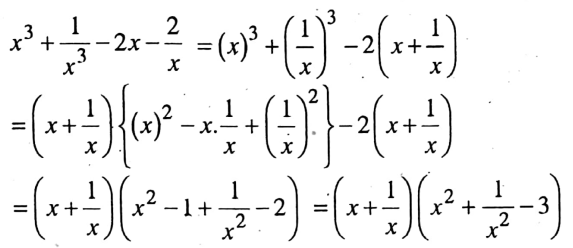
Question 26. Factorize : 8a3 – b3 + 1 + 6ab.
Solution :
Given 8a3 – b3 + 1 + 6ab
8a3– b3 + 1 + 6ab = (2a)3 – (b)3 + 1 + 6ab
= (2a-b)3+ 3.2a.b(2a-b) + 1 + 6ab
= (2a-b)3 + (1)3 + 6ab (2a – 6) + 6ab
= (2a-b + 1){(2a-b)2-{2a-b)1 + 12) + 6ab (2a-b +1)
= (2a -6 + 1) {(2a)2 – 2.2a. 6 + (b)2 – 2a + 6 + 1} + 6ab (2a – b +1)
= (2a – 6 + 1) (4a2 – 4a6 + b2 – 2 a+b + 1) + 6 ab (2a – b +1)
= (2a -6 + 1)(4a2 -4a6 + 62 -2a+b + 1+ 6ab)
= (2a – b + 1)(4a2 + 2 ab + b2 – 2a + b + 1)
Using formula:
8a3 – 63 + 1 + 6ab = (2a)3 +(-6)3 +(1)3 – 3.2a.(-b).1
={2a + (-6) + 1}{(2a)2 +{-b)2 +(1)2 -2a.(-b) – (-b.) 1 – 1.2a }
= (2a-b + 1)(4a2 +b2 +1 + 2ab + b -2a)
8a3 – b3 + 1 + 6ab = (2a-b + 1)(4a2 +b2 +1 + 2ab + b -2a)
Question 27. Factorize : a6 + 32a3 – 64.
Solution:
Given a6 + 32a3 – 64
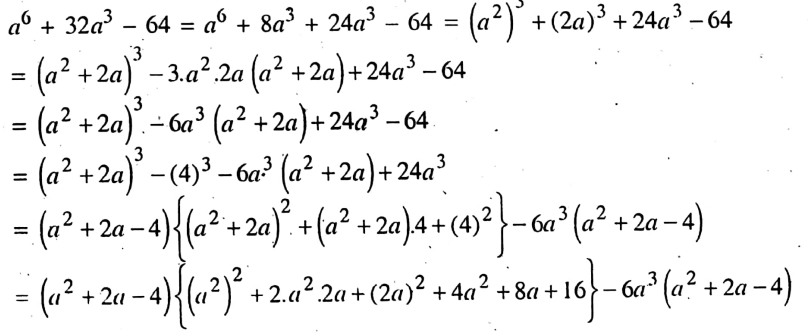
= (a2 + 2a-4)(a4 +4a³ +4a2 + 4a2 + 8a + 16-6a3)
= (a 2 + 2a – 4) (a4 – 2a2 + 8a2 + 8a + 16).
a6 + 32a3 – 64 = (a 2 + 2a – 4) (a4 – 2a2 + 8a2 + 8a + 16).
Question 28. Factorize : x3 + y3 – 12xy + 64.
Solution:
Given x3 + y3 – 12xy + 64
x3 + y3 – 12xy + 64

Question 29. Factorize: (2x – y)3 – (x + y)3 + (2y – x)3.
Solution:
Given (2x – y)3 – (x + y)3 + (2y – x)3
(2x – y)3 – (x + y)3 + (2y – x)3

Question 30. \(a^3+\frac{1}{a^3}+\frac{26}{27}\)
Solution:
\(a^3+\frac{1}{a^3}+\frac{26}{27}\) = \(\left(a+\frac{1}{a}\right)^3-3 \cdot a \cdot \frac{1}{a}\left(a+\frac{1}{a}\right)+1-\frac{1}{27}=\left(a+\frac{1}{a}\right)^3-\left(\frac{1}{3}\right)^3-3\left(a+\frac{1}{a}\right)\)

Question 31. Find the value of (80)3– (51)3– (29)3.
Solution :
Given (80)3– (51)3– (29)3
Here, (80)3+ (- 51)3 + (- 29)3
Let, 80 – a, -51 = b, and -29 = c.
∴ a+b+c = 80 – 51 – 29 = 0
a3 + b3 + c3 = 3abc (by formula)
(80)3 + (-51)3 + (- 29)3 = 3 x 80 x (-51) x (- 29)
or, (80)3 – (51)3 – (29)3 = 354960.
Question 32. If a+ b .+ c = 9, a2 + b2 + c2 = 27 and a3 + b2 + c3 = 81, then find the value of 3abc.
Solution :
Given a2 + b2 + c2 = 27 And a3 + b2 + c3 = 81
We know, (a+ b + c)2 = a2 + b2 + c2 + 2 (ab + bc + ca)
or, 92 = 27 + 2 (ab + be + ca) or, 2 (ab + be + ca) = 54
or, ab + bc + ca = 27
Again, a2 + b2 + c2 – 3abc = (a + b + c)(a2 + b2 + c2 – ab – bc – ca)
or, 81 – 3abc = 9 (27 – 27)
or, 81 – 3abc = 9 x 0
∴ 3abc = 81
Question 33. If a+ b+ c = 8, abc = 8 and ab + be + ca = 10, then determine the value of a3 + b3 + c3.
Solution:
Given abc = 8 And ab + be + ca = 10
We know, (a + b+ c)2 = (a2 + b2 + c2) + 2 (ab + bc + ca)
or, 82 = (a2 + b2 + c2) + 2 x 10 or, a2 + b2 + c2 = 64 – 20 = 44
Again, a2 + b3 + c3 – 3abc = (a + b + c)(a2 + b2 + c2 – ab – be – ca)
or, a³ + b3 + c3 – 3 x 8 = 8 (44 – 10)
or, a3 + b3 + c3 – 24 = 8 x 34
or a3 + b3 + c3 = 296, it is the required value.
Question 34. Prove that \(\left(\frac{a}{b}-\frac{b}{c}\right)^3+\left(\frac{b}{c}-\frac{c}{a}\right)^3+\left(\frac{c}{a}-\frac{a}{b}\right)^3=\frac{3\left(c a-b^2\right)\left(a b-c^2\right)\left(b c-a^2\right)}{a^2 b^2 c^2}\)
Solution:
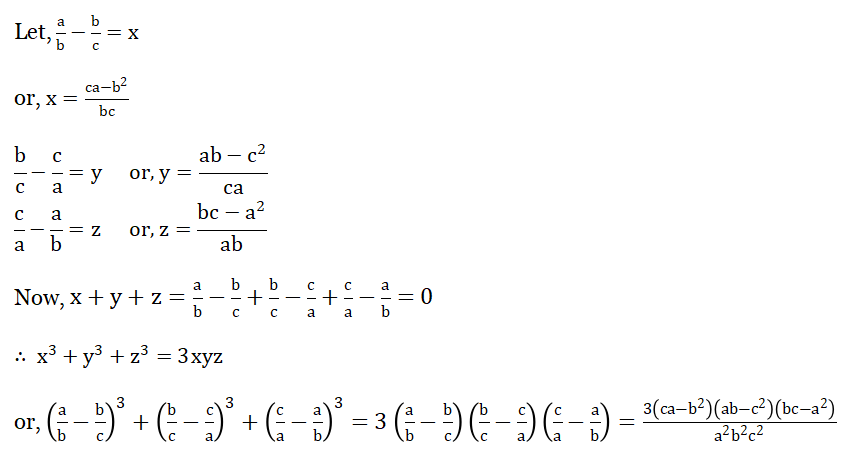
Algebra Chapter 1 Factorization By Splitting Middle Term
You have already learned that the standard form of a quadratic polynomial is ax2 + bx + c, a ≠ 0.
There are three terms in this expression, which are ax2, bx, and c.
The coefficient of the term ax2 is a, of the term bx is b and c is a constant term.
If a polynomial is given in this standard form, then to factorize this polynomial, we split the co efficient b of its middle term bx into two such parts that the algebraic sum of them is b and the product of them is ac, i.e., if these two parts be a and β, then α + β = b and αβ = ac.
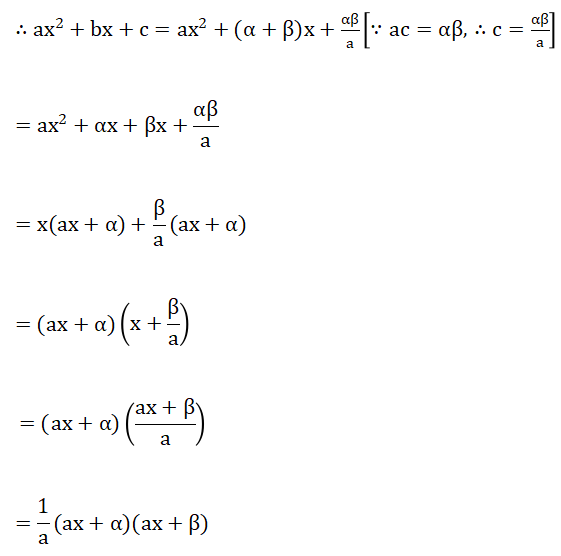
Again, if the polynomial is given in the form x2 + bx + c, then a + (3 – b and a(3 = c,
In this case, x2 + bx + c = x2 + (a + (3) x + a(3 = x2 + ax + |3jc + a(3
= x (x + a) + (3 (x + a) = (x + a) (x + (3).
Whether it is possible or not to factorize a given polynomial by this method of splitting the middle term generally depends on the following two conditions of the polynomial:
- The given polynomial should be a trinomial or it can be reduced to a trinomial.
- Amongst the three terms of the trinomial, the index of the variable of the first term must be an even positive integer and the difference between the two indices of the variables of any two consecutive terms must always be equal.
Such as the three terms of the polynomial ax2 + bx + c are ax2, bx, and c.
The index of the variable x of the first term ax2 is 2, which is an even positive integer, that of the second term is 1 and that of the third term is 0 (the index of the variable, assumed as x0, is always taken as 0).
That is, the indices of the three terms of the given polynomial are 2, 1, and 0, the differences of which are always equal as (2 – 1) = 1, (1 – 0) = 1, being taken consecutively.
Accordingly, if the index of the variable of the first term of the polynomial is 4, the two other indices must be 2 and 0 respectively.
Similarly, if the index of the variable of the first term is 6, the other two indices must be 3 and 0 respectively.
Only for this type of permutation of the indices of the variable of any given polynomial, it can be factorized by this method of splitting, the middle term.
Question 1. Factorize: x2 – 19x – 20.
Solution :
Given x2 – 19x – 20
x2-19x-20 = x2 – (20 – 1)x – 20 = x2 – 20x + x – 20
= x (x – 20) + 1 (x – 20) = (x – 20)(x + 1)
x2 – 19x – 20 = x (x – 20) + 1 (x – 20) = (x – 20)(x + 1)
Question 2. Factorize: 420 + x – x2.
Solution :
Given 420 + x – x2
420 + x- x2 = 420 + (21 – 20) x – x2
= 420 + 21x – 20x – x2
= 21 (20 + x) – x (20 +x) = (20 + x )(21 – x) .
420 + x – x2 = 21 (20 + x) – x (20 +x) = (20 + x )(21 – x) .
Question 3. Factorize: a2b2 – abc – 182 c2.
Solution :
Given a2b2 – abc – 182 c2
a2b2– abc – 182 c2 = a2b2 – (14 – 13)abc – 182c2
= a2b2 – 14abc + 13abc – 182 c2 = ab (ab – 14c) + 13c (ab – 14c)
= (ab – 14c)(ab + 13c)
a2b2 – abc – 182 c2 = (ab – 14c)(ab + 13c)
Question 4. Factorise : x4– 10x2 +16
Solution :
Given x4– 10x2 +16
x4– 10x2 + 16 = x4 – (2 + 8)x2 + 16 = x4 – 2x2 -8x2+16
= x2 (x2 – 2) – 8 (x2 – 2) = (x2 – 2)(x2 – 8)
x4– 10x2 +16 = (x2 – 2)(x2 – 8)
Question 5. Factorize: a6 – 7a3 – 60.
Solution :
Given a6 – 7a3 – 60
a6– 7a3 – 60 = a6 – (12 – 5)a3 -60
= a6 – 12a3 + 5a3 – 60
= a3 (a3 – 12) + 5 (a3 – 12)
= (a3 – 12)(a3 + 5)
a6 – 7a3 – 60 = (a3 – 12)(a3 + 5)
Question 6. Factorise : a8– a4 – 2
Solution :
Given a8– a4 – 2
a8– a4 – 2 = a8 – (2 – 1) a4 – 2
= a8 – 2a4 + a4– 2
= a4 (a4 – 2) + 1 (a4 – 2)
= (a4 – 2)(a4 + 1)
a8– a4 – 2 = (a4 – 2)(a4 + 1)
Question 7. Factorise : a6b6– ab3 – 6
Solution :
Given a6b6– ab3 – 6
a6b6– a3b3 – 6 = a6b6 – (3 – 2)a3b3 – 6 = a6b6 – 3a3b3 + 2a3b3 – 6
= a3b3 (a3b3 – 3) + 2 (a3b3 – 3) = (a3b3 – 3)(a3b3 + 2)
a6b6– ab3 – 6 = (a3b3 – 3)(a3b3 + 2)
Question 8. Factorize: x2-√3x-18.
Solution:
Given x2-√3x-18
x2– √3x-18 = x2 – (3√3 – 2√3)x – 18 [ ∵ 3√3 x 2√3 =3 = 18]
= x2 -3√3x + 2√3x-18
= x(x-3√3) + 2√3(x-3√3)
= (x- 3√3)(x-2√3).
x2-√3x-18 = (x- 3√3)(x-2√3).
Question 9. Factorize: (x + 1)(x + 2)(3x – 1)(3x – 4) + 12.
Solution :
Given (x + 1)(x + 2)(3x – 1)(3x – 4) + 12
(x+ 1)(x + 2)(3x-1)(3x-4) + 12 = {(x + 1)(3x – 1)} {(x + 2)(3x-4)} +12
= (3x2 + 3x – x -1)(3x2 + 6x – 4x – 8) +12
= (3x2 + 2x – 1)(3x2 + 2x – 8) +12
= (a-1)(a-8) + 12 [putting 3x2 + 2x = a]
= a2 – a – 8a+8 + 12
=a2 – 9a + 20
=a2 – (4 + 5)a + 20
=a2 – 4a – 5a+ 20
= a(a – 4) – 5 (a – 4)
= (a – 4)(a – 5) = (3x2 + 2x – 4)(3x2 + 2x – 5) [ putting a = 3x2 + 2x]
=(3x2 + 2x-4){3x2+(5-3)x-5}
= (3x2+2x-4){3x2+5x-3x-5}
= (3x2+2x-4){x(3x + 5)-1(3x + 5)}
= (3x2+2x-4)(3x + 5)(x-1)
= (x-1)(3x + 5)(3x2+2x-4)
(x + 1)(x + 2)(3x – 1)(3x – 4) + 12 = (x-1)(3x + 5)(3x2+2x-4)
Question 10. Factorize : (x2 + 5x + 4)(x2 + 5x + 6)-15
Solution:
Given (x2 + 5x + 4)(x2 + 5x + 6)-15
(x2 + 5x + 4)(x2 + 5x + 6)-15
Let, x2+ 5x =a.
∴ Given expression
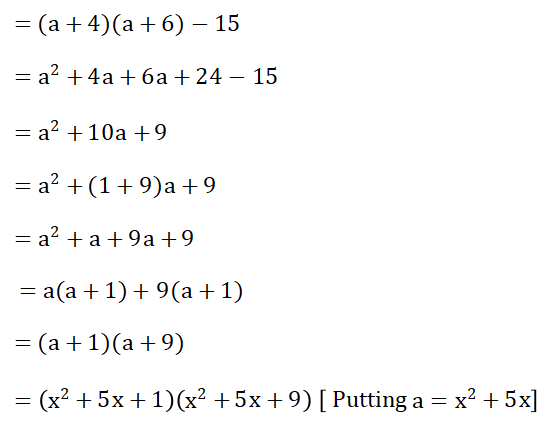
Question 11. Factorize : x2 – bx – (a + 3b)(a + 2b).
Solution:
Given x2 – bx – (a + 3b)(a + 2b)
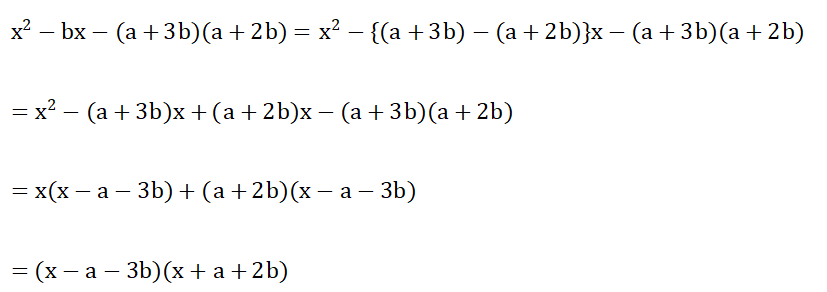
Question 12. Factorize: (a- 1) x2 – x – (a – 2)
Solution:
Given
(a- 1) x2 – x – (a – 2)
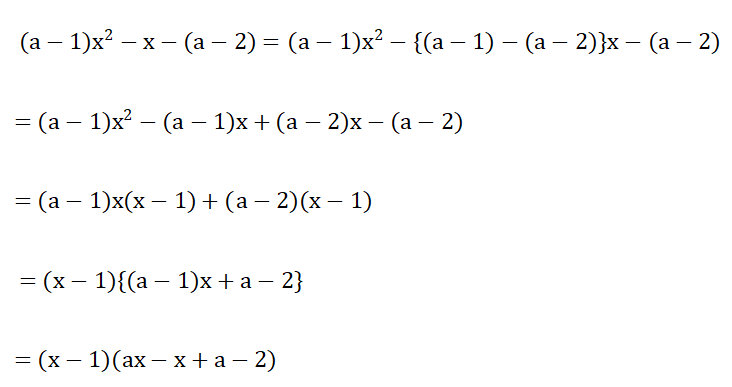
Question 13. Factorize : x2 + 4px + 4p2 + 2x + 4p – 15.
Solution:
Given x2 + 4px + 4p2 + 2x + 4p – 15
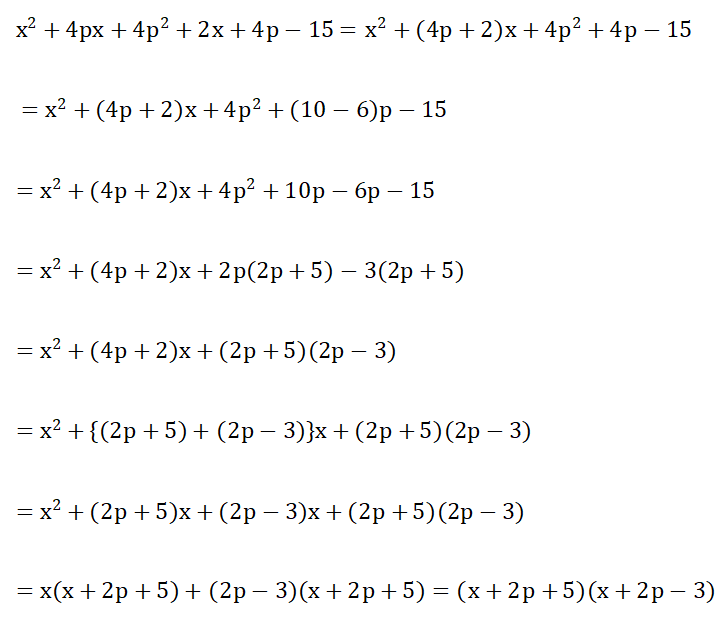
Question 14. Factorize : p2 + 2p – (q + 1)(q – 1).
Solution:
Given p2 + 2p – (q + 1)(q – 1)
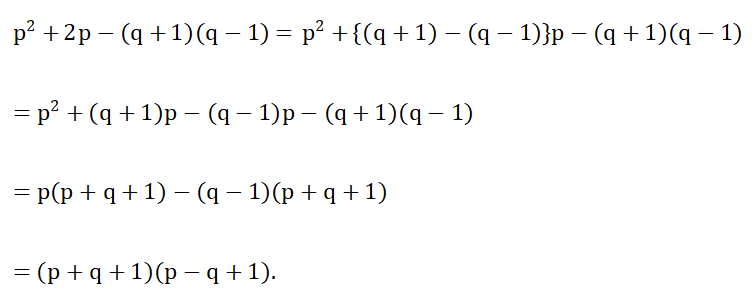
Question 15. Factorize: (x – 1)(x – 2)(x +3)(x+ 4) – 36.
Solution:
Given (x – 1)(x – 2)(x +3)(x+ 4) – 36
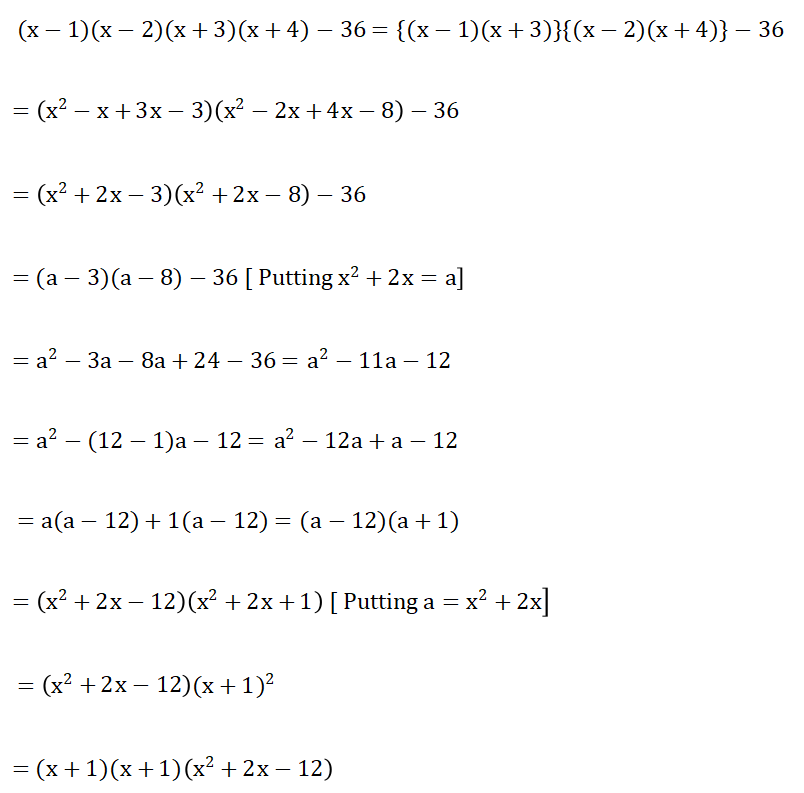
Question 16. Factorize: (a4+1) – 2a(a²+1) +2a².
Solution:
Given (a4+1) – 2a(a²+1) +2a²
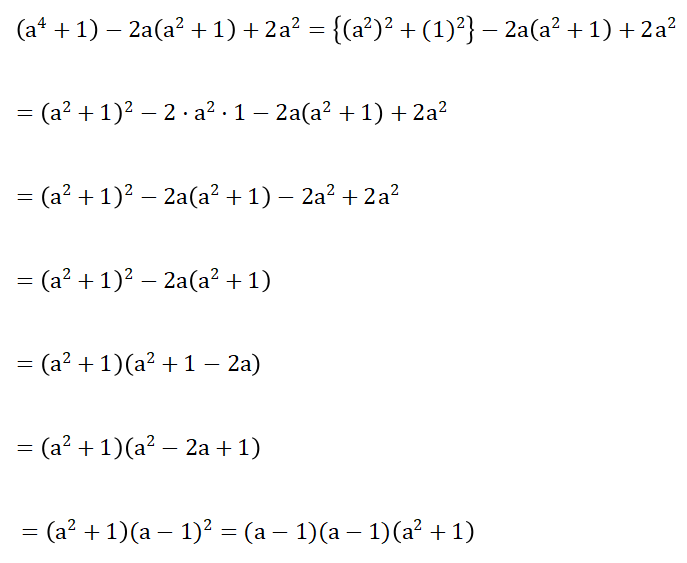
Question 17. Factorize: p2+ p-(a + l)(a + 2).
Solution:
Given p2+ p-(a + l)(a + 2)
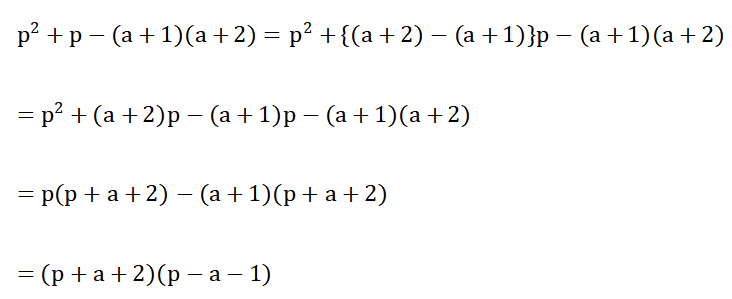
Question18. Factorize : (x – 1)(x – 2)(x + 3)(x + 4) + 6.
Solution:
Given (x – 1)(x – 2)(x + 3)(x + 4) + 6
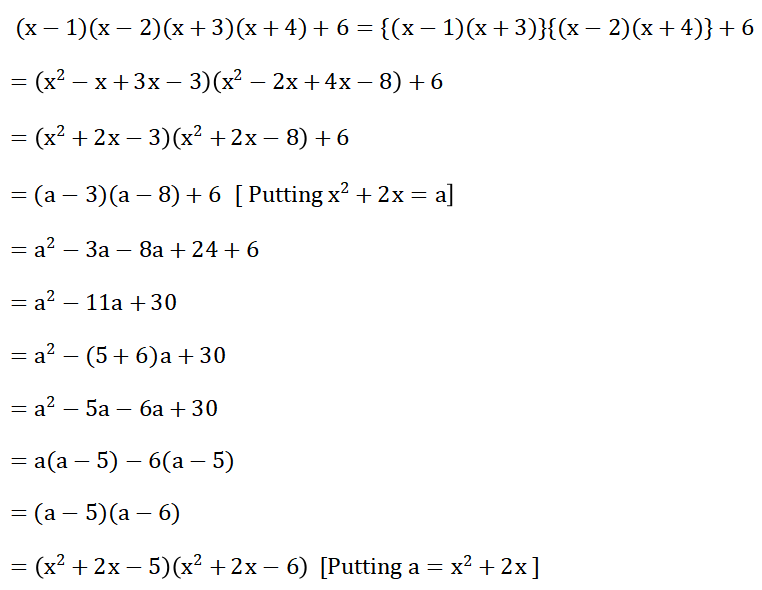
Question 19. Factorize : (x-y)2-x + y-2
Solution:
Given (x-y)2-x + y-2
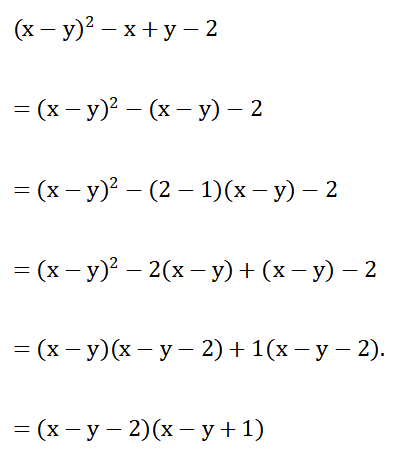
Alternative Method:
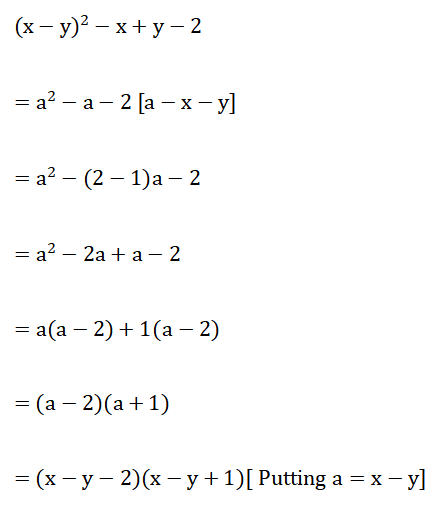
Question 20. Factorize : x2 + 6x – 27.
Solution:
Given x2 + 6x – 27
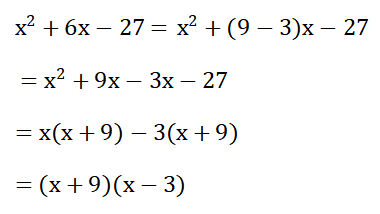
Question 21. Factorize : (a + b)2 – 4 (a + b) – 12.
Solution:
Given (a + b)2 – 4 (a + b) – 12
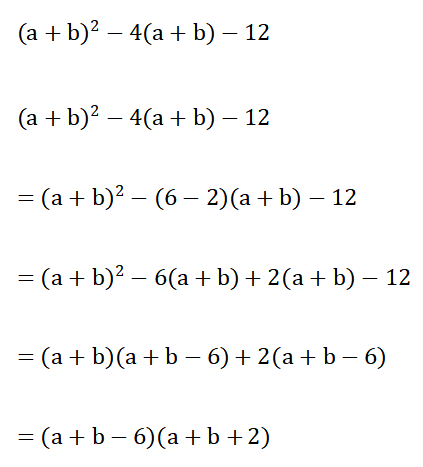
Question 22. Factorize : (x – 2)2 – 5 (x – 2) + 6.
Solution:
Given (x – 2)2 – 5 (x – 2) + 6
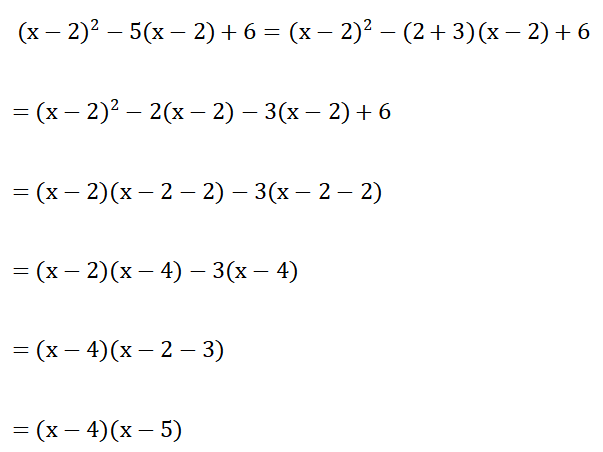
Question 23. Factorize : x2 – x – 6.
Solution:
Given x2 – x – 6
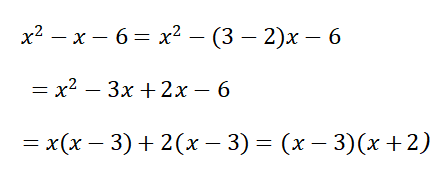
Question 24. Factorize : \(a^2+\left(p+\frac{1}{p}\right) a+1\)
Solution:
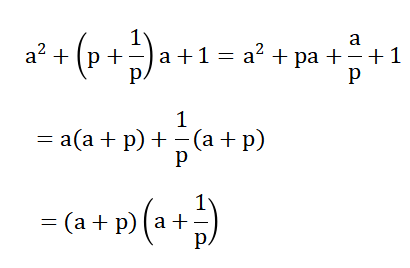
Question 25. Factorize : (x + 1)(x + 3)(x – 4)(x – 6) + 24.
Solution:
Given (x + 1)(x + 3)(x – 4)(x – 6) + 24
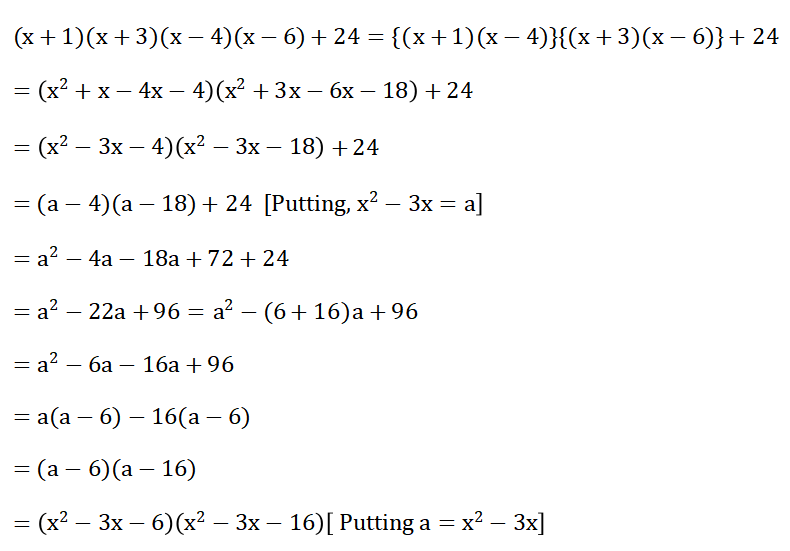
Question 26. Factorize : x (x + 1)(x + 2)(x + 3) – 15.
Solution:
Given x (x + 1)(x + 2)(x + 3) – 15
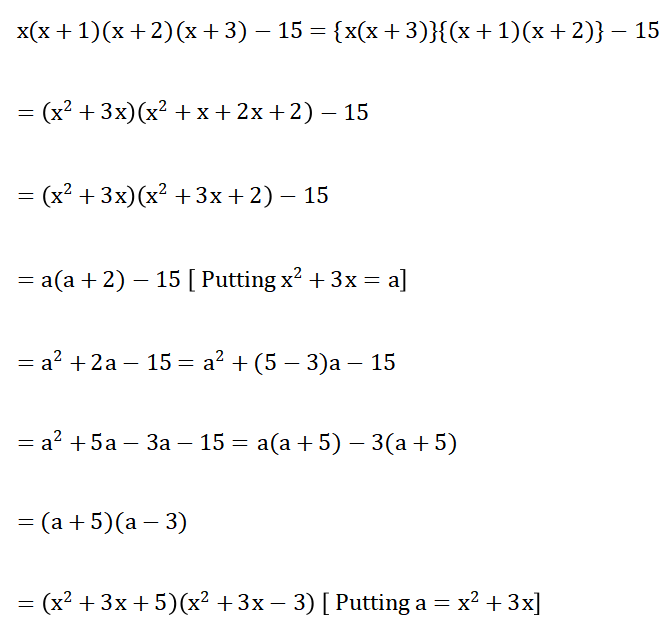
Question 27. Factorize : x4 + x2 – 2.
Solution:
Given x4 + x2 – 2
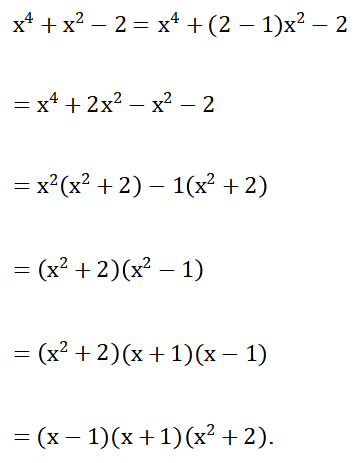
Question 28. Factorize : \(x^2-\left(2 a+\frac{1}{a}\right) x+2\)
Solution:
Given
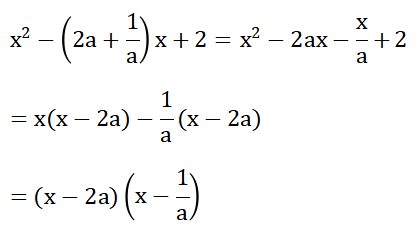
Question 29. Factorize : p (p – 1 )(p – 2)(p – 3) – 120.
Solution:
Given p (p – 1 )(p – 2)(p – 3) – 120
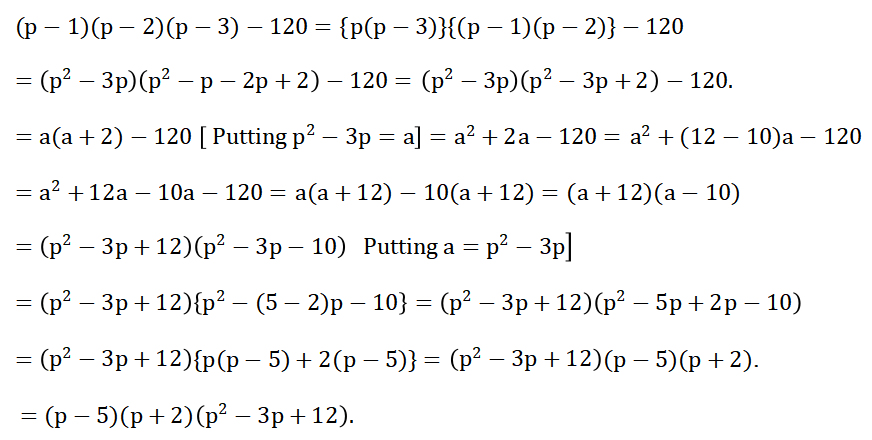
Question 30. Factorize : x²+3x-(a²+a-2).
Solution:
Given x²+3x-(a²+a-2)
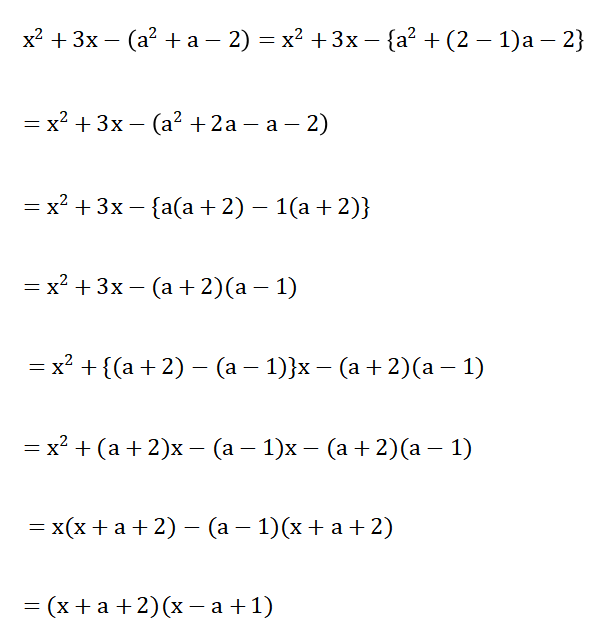
Question 31. Factorize : x (x + 1)(x + 2) – 3x – 3.
Question:
Given x (x + 1)(x + 2) – 3x – 3
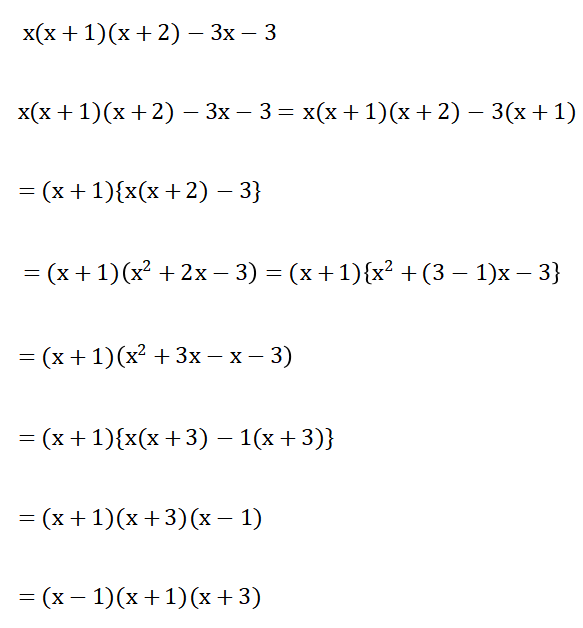
Question 32. Factorize : x2 + 2xy + y2 – 5x – 5y + 6.
Solution:
Given x2 + 2xy + y2 – 5x – 5y + 6
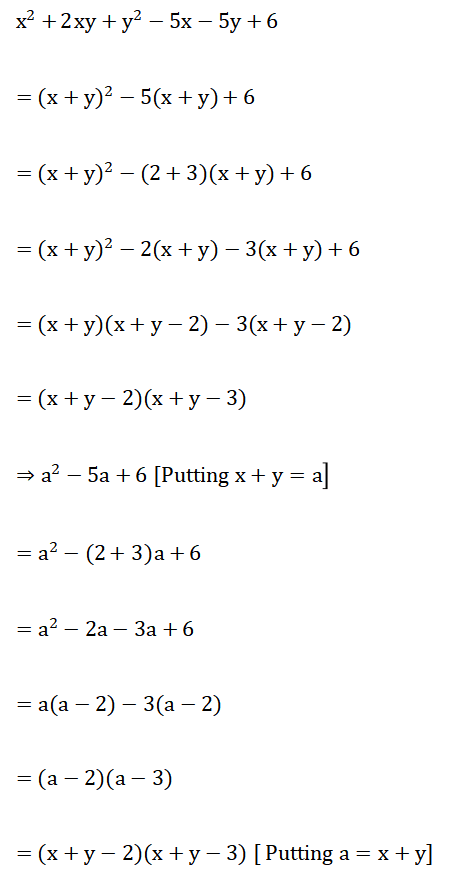
Question 33. Factorize : (a -1) x2 + x – (a – 2).
Solution:
Given (a -1) x2 + x – (a – 2)
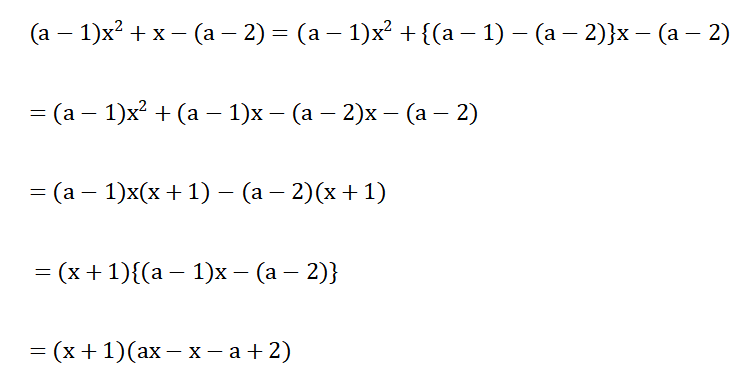
Question 34. Factorize : x (x – 1)(x – 2) – 3a + 3.
Solution:
Given x (x – 1)(x – 2) – 3a + 3
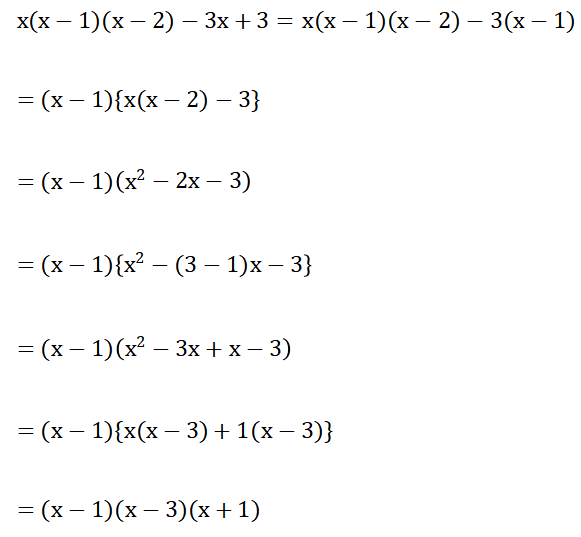
Question 35. Factorize : (a + b + 1)2 – 4 (a + b) – 25.
Solution:
Given (a + b + 1)2 – 4 (a + b) – 25
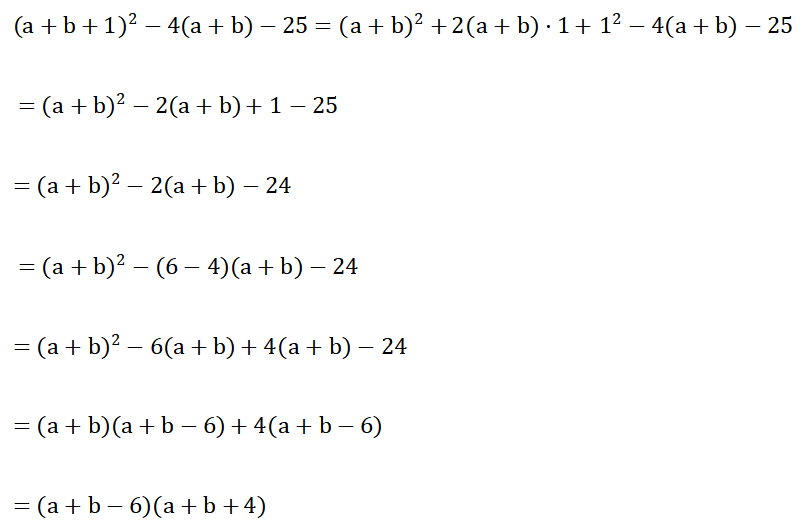
Question 36. Factorize : 6 (x – y)2 – x + y – 15.
Solution:
Given 6 (x – y)2 – x + y – 15
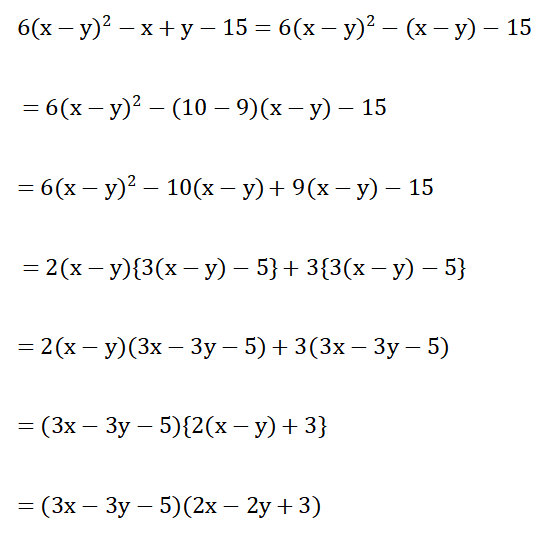
Question 37. Factorize : (b2 – a2)(x2 + 1) – 2 (a2 + b2) x.
Solution:
Given (b2 – a2)(x2 + 1) – 2 (a2 + b2) x
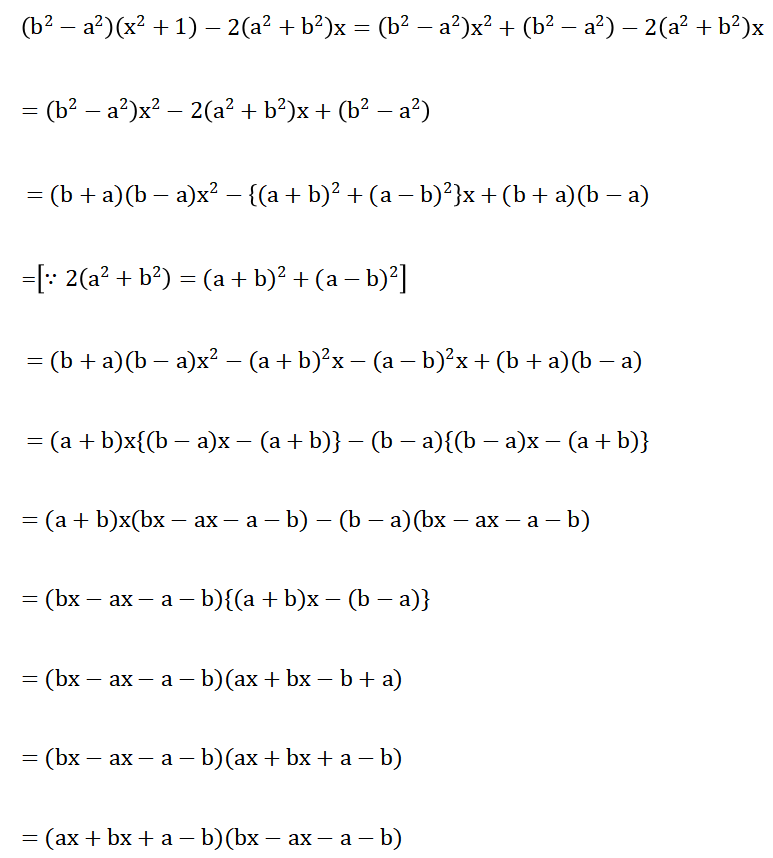
Question 38. Factorize : \(2\left(a^2+\frac{1}{a^2}\right)-\left(a-\frac{1}{a}\right)-7\)
Solution:
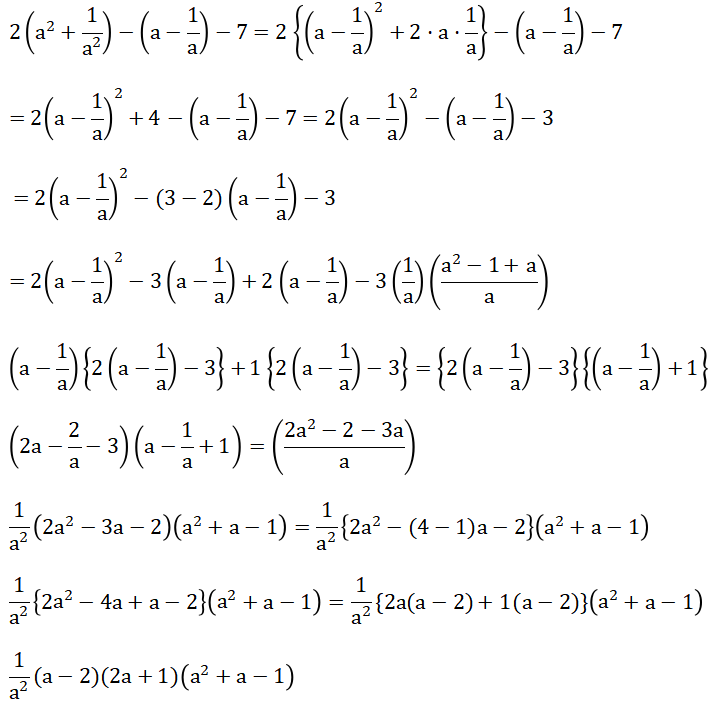
Algebra Chapter 1 Factorization Vanishing Method Or Trial Method
- The vanishing method or trial method of factorization of any given polynomial is a method of determining the factor (or factors) of the polynomial by finding its zero (or zeroes).
- This zero (or zeroes) is determined by experiment or trial, i.e., the values of the variable (or variables) for which the value of the given polynomial is zero, are determined by experiments or trials.
- For example, let f(x) = x2 + 2x – 3 be a given polynomial, we have to find its zero (or zeroes), i.e., we want to determine the values of the variable x for which the value of / (a) is zero.
- Now putting x = 0 in f (x) we get, f (0) = 02 + 2-0 – 3 = – 3 ≠ 0.
- Putting x = I in f(x) we get, f(I) = l2 + 2-l – 3 = 1 + 2- 3 = 0
- x = l is a zero of the polynomial f(x) = x2 + 2x – 3.
- Again, putting x = 2 in f (x) we get, f (2) = 22 + 2-2 – 3 = 4 + 4 – 3 = 5 ≠ 0.
- Putting x = 3 in f (x) we get, f (3) = 32 + 2-3 – 3 = 9 + 6 – 3 = 12 ≠ 0.
- Putting x = – 3 in f (x) we get, f (- 3) = (- 3)2 + 2 x (- 3) – 3 = 9 – 6 – 3 = 0.
- ∴ x = – 3 is another zero of the polynomial f(x) = x + 2x – 3.
- Thus, the zeroes of the given polynomial are determined by putting the different values of the variable in the given polynomial on a trial basis.
- Now. the question is there any easy rule or method of finding the exact values of the variable for which1 the value of the polynomial is zero? In reply, it can be said that
- 1. If the co-efficient of the term, contains the highest power of the variable of the polynomial then the zero of this polynomial will be any one of the factors of the constant term of the polynomial Such as the coefficient of x2, the term containing the highest power of a, in the polynomial
- f(x) = x2 + 2x – 3 is 1, therefore the zeroes of f(x) will be any one of (± 1) and (± 3), which are the factors of the constant term 3 of f(a).
- We have already seen in the above that (+ 1) and (- 3) are two zeroes of f(x) = x2 + 2x – 3.
- If the co-efficient of the term containing the highest power of the variable in the given polynomial is a and the constant term is 1, then the zeroes of the polynomial are either the factors of a or the factors of c or the numbers obtained by the division of \(\)
- For example, let f (x) = 2x2 + x – 3 be a polynomial.
- We have to factorize it.
- Then the coefficient of the term containing the highest power of the variable a in the polynomial is 2, the factors of which are ± 1 and ± 2.
- Also, the factors of the constant term 3 are ± 1 and ± 3. So, the zeroes of f(x) must lie amongst the number ± 1, ±2, ±3, ±\(\frac{1}{3}\),±\(\frac{2}{3}\),±\(\frac{3}{2}\).
- Generally, taking these values of x, trials are made successively, and we shall get the zeroes of f(x).
Now,
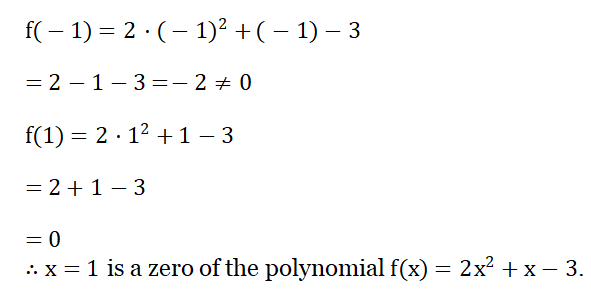
Again,
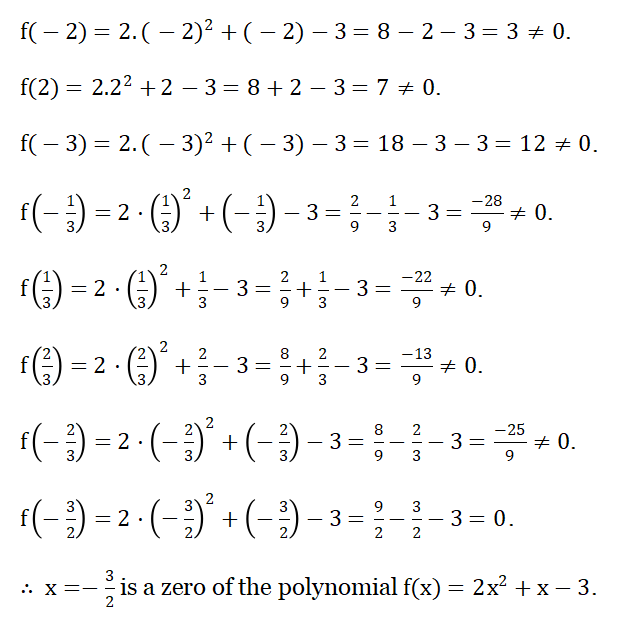
It is a lengthy process. So that we take a probable value of x by general observation and then determine the zeroes of the given polynomial by successive trials.
After the determination of the zeroes of the polynomial by this trial method, we use the factor theorem to identify the factors of the polynomial.
For example, let x = a be a zero of the polynomial f(x).
Then according to the factor theorem, (x – a) is a factor of f (x).
In this way, is it possible to know exactly how many factors are there in a given polynomial?
The answers are:
1. If the given polynomial is a quadratic one, then there exists only two factors of the polynomial and both factors are linear.
2. if it is a cubic one, then
- There exist three factors each of which is a linear polynomial; or
- There exist two factors of which one is linear and the other is a quadratic polynomial.
3. if it is a biquadratic one, then
- There exist four factors, each of which is a linear polynomial; or
- There exist two factors, one of which is linear and the other is a cubic polynomial; or
- There exist two factors, each of which is a quadratic polynomial; or
- There exist three factors, one of which is quadratic and the other two are linear polynomials.
According to the above pattern, the polynomials of degrees more than four will have factors more than four.
However, the sum of the degrees of each factor is always equal to the degree of the original polynomial.
If (x – a) is a factor of the polynomial fn(x) of degree n, then fn (x) = (x − a) fn-1 (x).
Similarly, if (x – b) is another factor of fn (x), then
fn (x) = (x – a) (x – b) fn-2 (x), and so on.
So, (x-1) and (x + 3) are the two factors of the polynomial f (x) = x2+2x-3, such that f(x) = x2+2x-3= (x − 1)(x+3).
Again, after determining one of the factors of the given polynomial, we can factorize it in the following manner:
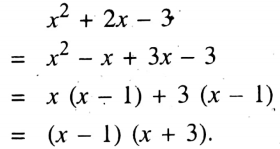
Her, (x – 1) is assumed as the known factor which is determined at the first time.
Now,
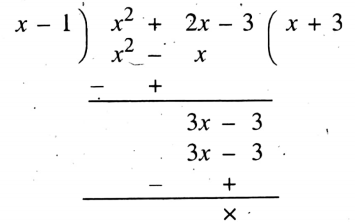
∴ x2 + 2x – 3 = (x – 1) (x + 3).
∴ After the determination of one of the two factors of a given polynomial of degree 2, we can find the other factor by a simple division algorithm.
Since in this vanishing or trial method, the factor theorem is used, it is also known as the method of factorization of the polynomials by using factor theorem.
Observe the following examples to know much more about this method of factorization.
Examples 1. Factorize (using factor theorem): 12 – 7x + 1.
Solution : Let f (x) = 12x2 – 7x + 1.
Here, the co-efficient of x2 is 12, the factors of which are ± 1, ± 2, ± 3, ± 4, ± 6, ± 12 and the constant term is 1, the factors of which are ± 1. .
the zeroes of f(x) must be among the numbers
±1,±2,±3,±4,±6,±12, ±\(\pm \frac{1}{2}, \pm \frac{1}{3}, \pm \frac{1}{4}, \pm \frac{1}{6}, \pm \frac{1}{12}\)
But, by general observations, let us choose x = \(\frac{1}{3}\)
Now,
\(f\left(\frac{1}{3}\right)=12 \times\left(\frac{1}{3}\right)^2-7 \times \frac{1}{3}+1=\frac{12}{9}-\frac{7}{3}+1=0\)∴ x = \(\frac{1}{3}\) is zero of f(x).
∴ according to the factor theorem (3x-1) is a factor of f (x).
Now,
122 -7x + 1 = 122 – 4x – 3x + 1 = 4x (3x – 1) – 1 (3x – 1) = (3x – 1)(4x -1)
Question 2. Factorize(using factor theorem): x4+ 3x3 + 3x2 + 2x + 1
Solution:
Given x4+ 3x3 + 3x2 + 2x + 1
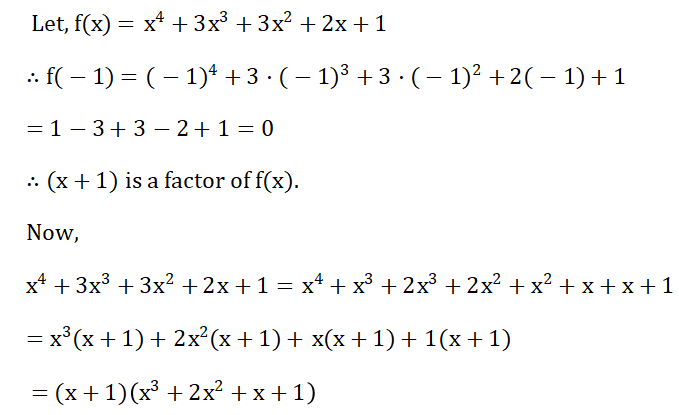
Question 3. Factorise (using factor theorem): x3-x2 -(2-√2)x + √2.
Solution:
Given x3-x2 -(2-√2)x + √2
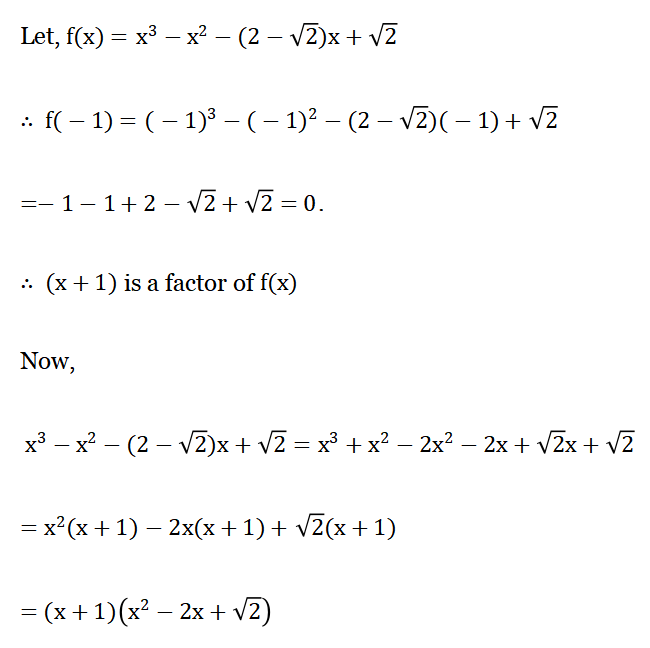
Question 4. Factorize(using factor theorem) : x3 – 3x2 – 9x – 5.
Solution:
Given x3 – 3x2 – 9x – 5
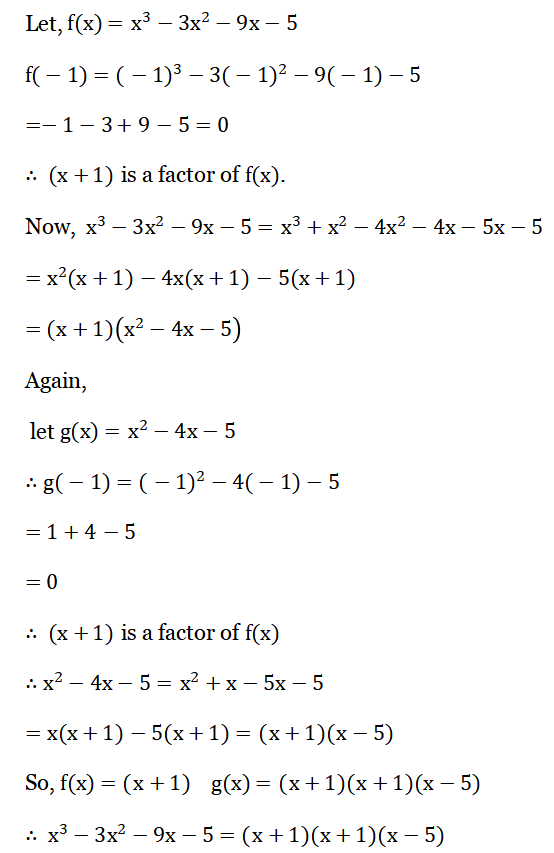
Question 5. Factorize(using factor theorem) : 8a3 + 4a – 3.
Solution:
Given 8a3 + 4a – 3
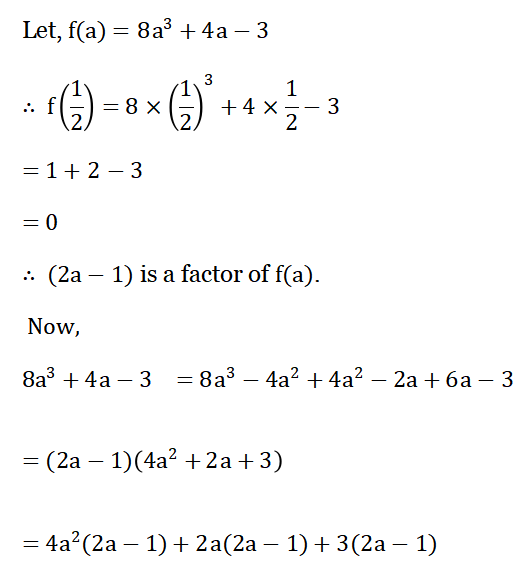
Question 6. Factorize (using factor theorem): 2x3 – x – 1.
Solution:
Given 2x3 – x – 1
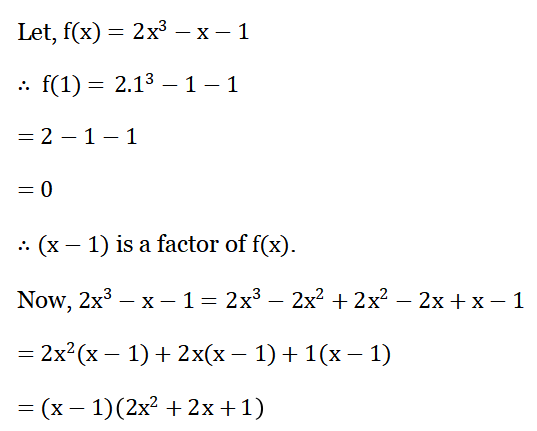
Question 7. Factorize(using factor theorem) : 4a3– 9a2 + 3a + 2.
Solution:
Given 4a3– 9a2 + 3a + 2
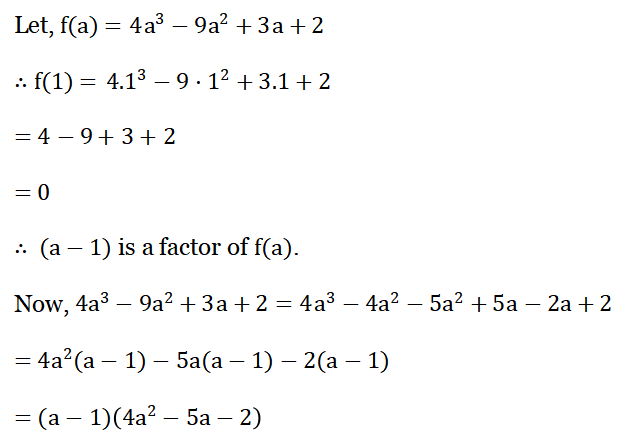
Question 8. Factorize(using factor theorem): 5a3 + 11a2+4a – 2.
Solution:
Given 5a3 + 11a2+4a – 2
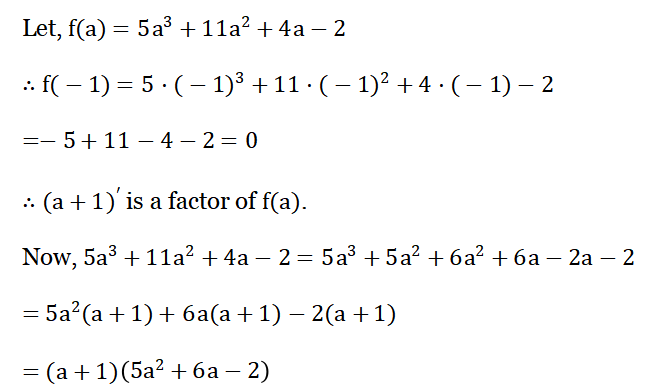
Question 9. Factorize (using factor theorem): 2y3 – 5y2 – 19y + 42.
Solution:
Given 2y3 – 5y2 – 19y + 42
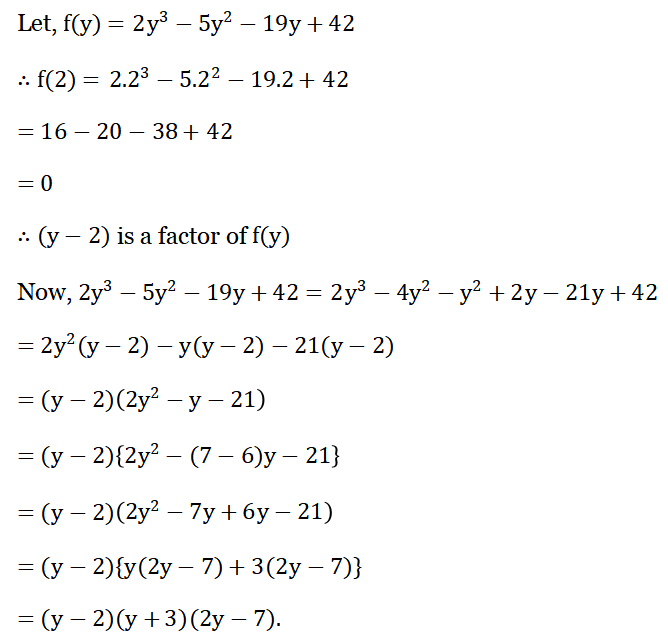
Question 10. Factorize (using factor theorem): x3 – 9x2 + 23x – 15.
Solution:
Given x3 – 9x2 + 23x – 15
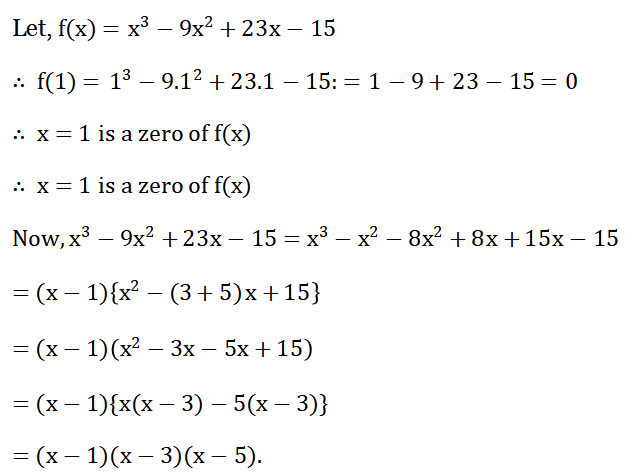
Question 11. Factorise (using factor theorem): a4+ 5a³ + 8a² + 5a + 1.
Solution:
Given a4+ 5a³ + 8a² + 5a + 1
Let, f (a) = a4+ 5a³ + 8a² + 5a + 1
∴ f(-1)=(-1)4 +5.(1)³ + 8.(-1)² + 5. (1) + 1
= 1 – 5 + 8 – 5 + 1
=0
a = 1 is a zero of f (a)
i.e., (a + 1) is a factor of f(a).
Now, f(a)= a4 + 5a³+ 8a²+ 5a + 1
= a² + a² + 4a³ + 4a² + 4a² + 4a + a + 1
= a³ (a + 1) + 4a² (a + 1) + 4a (a + 1) + 1 (a + 1)
=(a+1)(a³ + 4a² + 4a+1)
= (a + 1) g (a) ………… (1),
where g(a) = a³ + 4a² + 4a + 1
g(-1)=(-1)³+ 4. (-1)²+ 4. (-1) + 1
= 1+ 4 – 4 + 1
= 0
a = 1 is a zero of g (a)
∴ (a+1) is a factor of g (a).
g (a)= a³ + 4a² + 4a+1
= a³ + a² + 3a² + 3a + a + 1
= a¹ (a+1)+ 3a (a + 1) + 1 (a + 1)
= (a+1)(a² + 3a + 1)
∴ f (a) = (a + 1) g (a) [by (1)]
= (a + 1)(a + 1)(a² + 3a + 1) [ by (2) ]
= a4+ 5a³ + 8a² + 5a + 1
= (a+1)(a + 1)(a² + 3a + 1).
a4+ 5a³ + 8a² + 5a + 1 = (a+1)(a + 1)(a² + 3a + 1).
Question 12. Factorize(using factor theorem): 2x4 – 5x3 + 6x2 – 5x + 2.
Solution:
Given 2x4 – 5x3 + 6x2 – 5x + 2
Let. f (x) = 2x4 – 5×3 +62-5x+2
f(1) 2 = (1)4– 5. (1)³ + 6. (1)² – 5. (1) +2
= 25 +65 +2
=0
x = 1 is a zero of f (x).
∴ (x – 1) is a factor of f (x).
f(x)=2x4 – 5x³ + 6x² – 5x + 2
=2x4 – 2x³ – 3x² + 3x² + 3x² – 3x – 2x + 2
=2(x-1)-3(x-1)+3(x-1)-2(x-1)
=(x – 1)(2x³ – 3x² + 3x – 2)……….(1),
where g(x) = 2x³ – 3x² + 3x – 2
= (x – 1) g (x)
∴ g (1) = 2.1³ – 3. 1² + 3.1-2
= 2 – 3 + 3 – 2
=0
∴ x = 1 is a zero of g (x).
∴ (x – 1) is a factor of g (x).
g (x)=2x³ – 3x² + 3x – 2
= 2x³ – 2x² – x² +2x – 2
=2x²(x-1) – x (x 1) + 2(x-1)
= (x – 1)(2x² – x + 2).
f(x) = (x – 1) g (x) [ by (1) ] = 2x4 – 5x³ + 6x² – 5x + 2
= (x – 1)(x – 1)(2x² – x + 2) ……………(2)
= (x – 1)(x – 1)(2x² – x + 2) [ by (2)]
∴ 2x4 – 5x³ + 6x² -5x + 2 = (x – 1)(x – 1)(2x² – x + 2)
Algebra Chapter 1 Factorization Of Polynomials Of Three Variables In A Cyclic Order
- There are some polynomials that have three variables. The important criteria of these variables are that they are arranged in a cyclic order. So, what is a cyclic expression?
- Observe the expression (ab+bc+ca) minutely. There are three variables namely a, b, and c in this expression.
- There are also three terms in this expression. The terms are ab, bc, and ca.
- The first (alphabets) of the terms are a, b, and c and the second alphabets are b, c, and a.
- The first arrangement is; at first a, then b, and then c.
- The second arrangement is at first b, then c, and then a.
- Now, if these three variables be fixed in a circular ring and are then revolved clockwise, we see that these three variables a, b, and c are always crossing a fixed point P (as in the figure) along the horizontal line according to a fixed order of which there is no exception, i.e., the order of crossing the point P is b after a, c after b and again a after c.
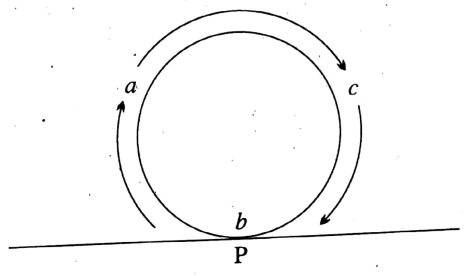
- Therefore, we can say that the variables a, b, and c are arranged in the expression (ab+bc+ca) in a cyclic order and we call this type of expression the cyclic expression.
- Hence, if the variables of any polynomial be arranged in a cyclic order within it, the polynomial is called a cyclic expression or cyclic polynomial.
- For examples, a + b + c; ab + bc + ca, a2b2 + b2c2 + c2a2, a2 (b – c) + b2 (c – a) + c2 (a – b), a2 (b+c) + b2 (c + a) + c2 (a + b),…… etc are cyclic expressions.
- Our interest is to factorize these expressions.
- To do so, the principle we generally apply is
- If (a+b) is a factor of any cyclic expression, then (b + c) may be a factor of the same and if (b+c) is a factor of the cyclic expression, then (c + a) may also be a factor of the same. Because, (a + b), (b + c), and (c + a) are arranged in a cyclic order.
- Similarly, if (a – b) is a factor of any cyclic expression, then (b – c) may be a factor of the same, and if (b – c) is a factor of any cyclic expression, then (c – a) may also be a factor of the same, for the expressions (a – b), (b – c) and (c – a) are arranged in a cyclic order.
- We shall factorize the cyclic polynomials according to the above principle.
- You should have a keen observation of how this principle is applied in the following examples.
Question 1. Factorize : a2(b+c) + b2(c+a)+ c2(a + b) + 2abc.
Solution:
Given a2(b+c) + b2(c+a)+ c2(a + b) + 2abc
\(\begin{aligned}& a^2(b+c)+b^2(c+a)+c^2(a+b)+2 a b c \\
& =a^2(b+c)+b^2 c+a b^2+c^2 a+b c^2+a b c+a b c \\
& =a^2(b+c)+b c(b+c)+a b(b+c)+c a(b+c) \\
& =(b+c)\left(a^2+b c+a b+c a\right) \\
& =(b+c)\{a(c+a)+b(c+a)\} \\
& =(b+c)(c+a)(a+b)
\end{aligned}\)
Question 2. Factorize : a2(b-c) +b2(c-a) + c2(a-b).
Solution:
Given a2(b-c) +b2(c-a) + c2(a-b)
\(\begin{aligned}& a^2(b-c)+b^2(c-a)+c^2(a-b) \\
& =a^2(b-c)+b^2 c-a b^2+c^2 a-b c^2 \\
& =a^2(b-c)+b c(b-c)-a\left(b^2-c^2\right) \\
& =(b-c)\left\{a^2+b c-a(b+c)\right\} \\
& =(b-c)\left(a^2+b c-a b-c a\right) \\
& =(b-c)\{b(c-a)-a(c-a)\} \\
& =(b-c)(c-a)(b-a) \\
& =-(b-c)(c-a)(a-b)[b-a=-(a-b)]
\end{aligned}\)
Question 3. Factorize : a2(b+c) + b2(c+a) + c2(a + b) + 3abc.
Solution:
Given a2(b+c) + b2(c+a) + c2(a + b) + 3abc
\(\begin{aligned}& a^2(b+c)+b^2(c+a)+c^2(a+b)+3 a b c \\
& =a^2 b+c a^2+b^2 c+a b^2+c^2 a+b c^2+a b c+a b c+a b c \\
& =\left(a^2 b+a b c+c a^2\right)+\left(a b^2+b^2 c+a b c\right)+\left(a b c+b c^2+c^2 a\right) \\
& =a(a b+b c+c a)+b(a b+b c+c a)+c(a b+b c+c a) \\
& =(a b+b c+c a)(a+b+c)
\end{aligned}\)
Question 4. Factorize: a3(b-c)+ b3(c-a) + c3(a-b)
Solution:
Given a3(b-c)+ b3(c-a) + c3(a-b)
\(\begin{aligned}& a^3(b-c)+b^3(c-a)+c^3(a-b)=a^3(b-c)+b^3 c-a b^3+c^3 a-b c^3 \\
& =a^3(b-c)-a\left(b^3-c^3\right)+b c\left(b^2-c^2\right) \\
& =(b-c)\left\{a^3-a\left(b^2+b c+c^2\right)+b c(b+c)\right\} \\
& =(b-c)\left(a^3-a b^2-a b c-c^2 a+b^2 c+b c^2\right) \\
& =(b-c)\left\{-a\left(c^2-a^2\right)+b^2(c-a)+b c(c-a)\right\} \\
& =(b-c)(c-a)\left\{-a(c+a)+b^2+b c\right\} \\
& =(b-c)(c-a)\left(-c a-a^2+b^2+b c\right) \\
& =(b-c)(c-a)\left\{-c(a-b)-1\left(a^2-b^2\right)\right\} \\
& =(b-c)(c-a)(a-b)\{-c-1(a+b)\} \\
& =(b-c)(c-a)(a-b)(-c-a-b) \\
& =-(a-b)(b-c)(c-a)(a+b+c) .[-c-a-b=-(a+b+c)]
\end{aligned}\)
Question 5. Factorize : a(b2+ c2) + b(c2 + a2) + c(a2 +b2) + 3abc.
Solution:
Given a(b2+ c2) + b(c2 + a2) + c(a2 +b2) + 3abc
\(\begin{aligned}& a\left(b^2+c^2\right)+b\left(c^2+a^2\right)+c\left(a^2+b^2\right)+3 a b c \\
& =a b^2+a c^2+b c^2+a^2 b+c a^2+b^2 c+a b c+a b c+a b c \\
& =\left(a^2 b+a b c+c a^2\right)+\left(a b^2+b^2 c+a b c\right)+\left(a b c+b c^2+c^2 a\right) \\
& =a(a b+b c+c a)+b(a b+b c+c a)+c(a b+b c+c a) \\
& =(a b+b c+c a)(a+b+c)
\end{aligned}\)
Question 6. Factorize: bc (b +c) +ca (c + a) +ab (a + b) + a3 + b3 + c3
Solution:
Given bc (b +c) +ca (c + a) +ab (a + b) + a3 + b3 + c3
\(\begin{aligned}& \{b c(b+c)+c a(c+a)+a b(a+b)+3 a b c\}+\left(a^3+b^3+c^3-3 a b c\right) \\
& =\left(b^2 c+b c^2+c^2 a+c a^2+a^2 b+a b^2+a b c+a b c+a b c\right)+\left(a^3+b^3+c^3-3 a b c\right) \\
& =\left(a^2 b+a b^2+a b c\right)+\left(a b c+b^2 c+b c^2\right)+\left(c a^2+a b c+c^2 a\right)+\left(a^3+b^3+c^3-3 a b c\right) \\
& =a b(a+b+c)+b c(a+b+c)+c a(a+b+c)+\left(a^3+b^3+c^3-3 a b c\right) \\
& =(a+b+c)(a b+b c+c a)+(a+b+c)\left(a^2+b^2+c^2-a b-b c-c a\right) \\
& =(a+b+c)\left(a b+b c+c a+a^2+b^2+c^2-a b-b c-c a\right) \\
& =(a+b+c)\left(a^2+b^2+c^2\right)
\end{aligned}\)
Question 7. Factorize: a (b-c)3 + b (c-a)2+c (a-b)3.
Solution:
Given a (b-c)3 + b (c-a)2+c (a-b)3
\(\begin{aligned}& a(b-c)^3+b(c-a)^3+c(a-b)^3 \\
& =a\left(b^3-3 b^2 c+3 b c^2-c^3\right)+b\left(c^3-3 c^2 a+3 a^2-a^3\right)+c\left(a^3-3 a^2 b+3 a b^2-b^3\right) \\
& =a b^3-3 a b^2 c+3 a b c^2-c^3 a+b c^3-3 a b c^2+3 a^2 b c-a^3 b+c a^3-3 a^2 b c+3 a b^2 c-b^3 c \\
& =a b^3-c^3 a+b c^3-a^3 b+c a^3-b^3 c \\
& =a\left(b^3-c^3\right)-a^3(b-c)-b c\left(b^2-c^2\right) \\
& =(b-c)\left\{a\left(b^2+b c+c^2\right)-a^3-b c(b+c)\right\} \\
& =(b-c)\left(a b^2+a b c+c^2 a-a^3-b^2 c-b c^2\right) \\
& =(b-c)\left\{a\left(c^2-a^2\right)-b^2(c-a)-b c(c-a)\right\} \\
& =(b-c)(c-a)\left\{a(c+a)-b^2-b c\right\} \\
& =(a-b)(b-c)(c-a)(a+b+c)
\end{aligned}\)
Question 8. Factorize: x(y -z)2+y (z – x)2 + z(x – y)2 + 8xyz.
Solution:
Given x(y -z)2+y (z – x)2 + z(x – y)2 + 8xyz
\(\begin{aligned}& x(y-z)^2+y(z-x)^2+z(x-y)^2+8 x y z \\
& =x\left(y^2-2 y z+z^2\right)+y\left(z^2-2 z x+x^2\right)+z\left(x^2-2 x y+y^2\right)+8 x y z \\
& =x y^2-2 x y z+z^2 x+y z^2-2 x y z+x^2 y+x^2-2 x y z+y^2 z+8 x y z \\
& =x y^2+z^2 x+y z^2+x^2 y+x^2+y^2 z+2 x y z \\
& =x y(x+y)+y z(x+y)+z x(x+y)+z^2(x+y) \\
& =(x+y)\left(x y+y z+z x+z^2\right) \\
& =(x+y)\{z(y+z)+x(y+z)\} \\
& =(x+y)(y+z)(z+x)
\end{aligned}\)
Question 9. Factorize: a4(b-c) + b4(c-a) + c4(a-b).
Solution:
Given a4(b-c) + b4(c-a) + c4(a-b)
\(\begin{aligned}& a^4(b-c)+b^4(c-a)+c^4(a-b)=a^4(b-c)+b^4 c-a b^4+c^4 a-b c^4 \\
& =a^4(b-c)+b c\left(b^3-c^3\right)-a\left(b^4-c^4\right) \\
& =(b-c)\left\{a^4+b c\left(b^2+b c+c^2\right)-a(b+c)\left(b^2+c^2\right)\right\} \\
& {\left[ b^4-c^4=(b-c)(b+c)\left(b^2+c^2\right)\right]} \\
& =(b-c)\left(a^4+b^3 c+b^2 c^2+b c^3-a b^3-a b^2 c-a b c^2-a c^3\right) \\
& =(b-c)\left\{-a\left(c^3-a^3\right)+b c^2(c-a)+b^2 c(c-a)+b^3(c-a)\right\} \\
& =(b-c)(c-a)\left\{-a\left(c^2+c a+a^2\right)+b c^2+b^2 c+b^3\right\} \\
& =(b-c)(c-a)\left(-a c^2-c a^2-a^3+b c^2+b^2 c+b^3\right) \\
& =(b-c)(c-a)\left\{-c\left(a^2-b^2\right)-c^2(a-b)-1\left(a^3-b^3\right)\right\} \\
& =(b-c)(c-a)(a-b)\left\{-c(a+b)-c^2-1\left(a^2+a b+b^2\right)\right\} \\
& =(b-c)(c-a)(a-b)\left(-c a-b c-c^2-a^2-a b-b^2\right) \\
& =-(a-b)(b-c)(c-a)\left(a^2+b^2+c^2+a b+b c+c a\right)
\end{aligned}\)
Question 10. Factorize : a3(b2-c2) + b3(c2-a2)+c3 (a2 -b2).
Solution:
Given a3(b2-c2) + b3(c2-a2)+c3 (a2 -b2)
\(\begin{aligned}& a^3\left(b^2-c^2\right)+b^3\left(c^2-a^2\right)+c^3\left(a^2-b^2\right) \\
& =a^3\left(b^2-c^2\right)+b^3 c^2-a^2 b^3+c^3 a^2-b^2 c^3 \\
& =a^3\left(b^2-c^2\right)+b^2 c^2(b-c)-a^2\left(b^3-c^3\right) \\
& =(b-c)\left\{a^3(b+c)+b^2 c^2-a^2\left(b^2+b c+c^2\right)\right\} \\
& =(b-c)\left(a^3 b+c a^3+b^2 c^2-a^2 b^2-a^2 b c-c^2 a^2\right) \\
& =(b-c)\left\{-a^2 b(c-a)+b^2\left(c^2-a^2\right)-a^2(c-a)\right\} \\
& =(b-c)(c-a)\left\{-a^2 b+b^2(c+a)-c a^2\right\} \\
& =(b-c)(c-a)\left(-a^2 b+b^2 c+a b^2-c a^2\right) \\
& =(b-c)(c-a)\left\{-a b(a-b)-c\left(a^2-b^2\right)\right\} \\
& =(b-c)(c-a)(a-b)\{-a b-c(a+b)\} \\
& =(b-c)(c-a)(a-b)(-a b-c a-b c) \\
& =(a-b)(b-c)(c-a)(a b+b c+c a)
\end{aligned}\)
Question 11. Factorize: a² + (x²+y²)a + (x² – y²)²
Solution:
Given a² + (x²+y²)a + (x² – y²)²
\(\begin{aligned}& a^2+2\left(x^2+y^2\right) a+\{(x+y)(x-y)\}^2 \\
& =a^2+2\left(x^2+y^2\right) a+(x+y)^2(x-y)^2 \\
& =a^2+\left\{(x+y)^2+(x-y)^2\right\} a+(x+y)^2(x-y)^2 \\
& {\left[(x+y)^2+(x-y)^2=2\left(x^2+y^2\right)\right]} \\
& =a^2+(x+y)^2 a+(x-y)^2 a+(x+y)^2(x-y)^2 \\
& =a\left\{a+(x+y)^2\right\}+(x-y)^2\left\{a+(x+y)^2\right\} \\
& =\left\{a+(x+y)^2\right\}\left\{a+(x-y)^2\right\} \\
& =\left(a+x^2+2 x y+y^2\right)\left(a+x^2-2 x y+y^2\right)
\end{aligned}\)

